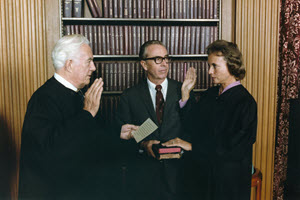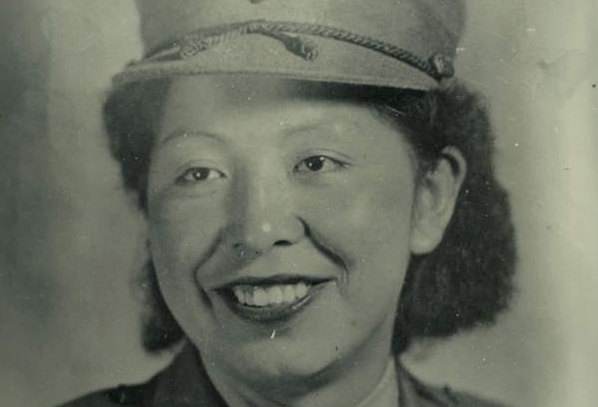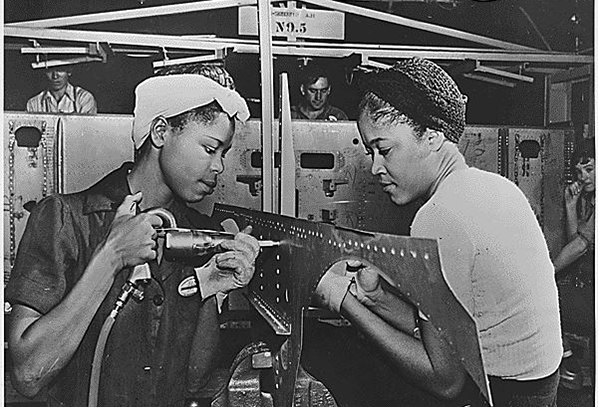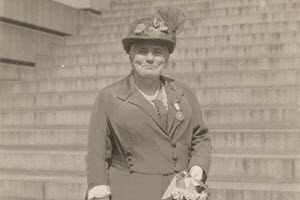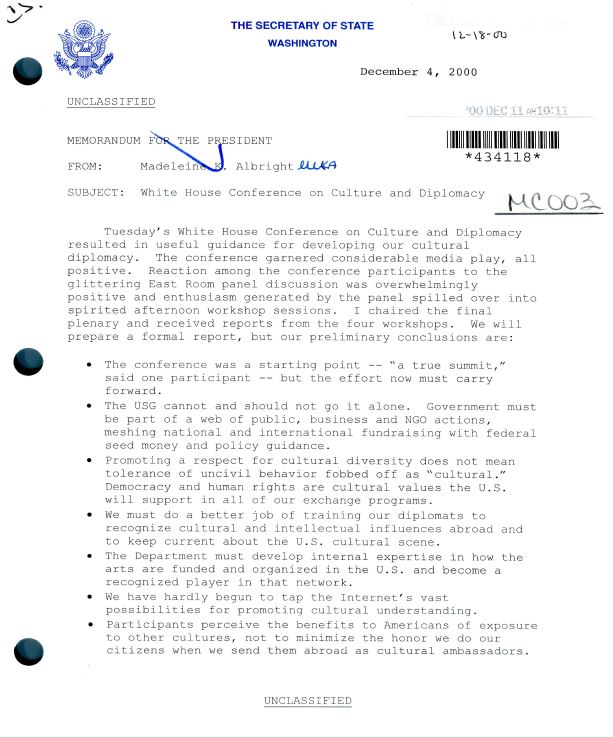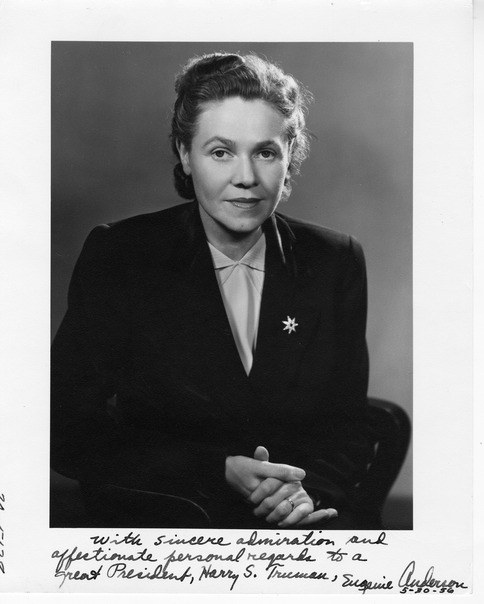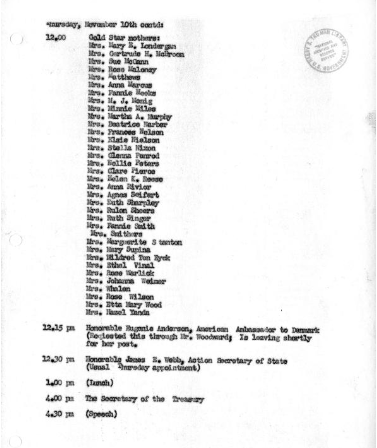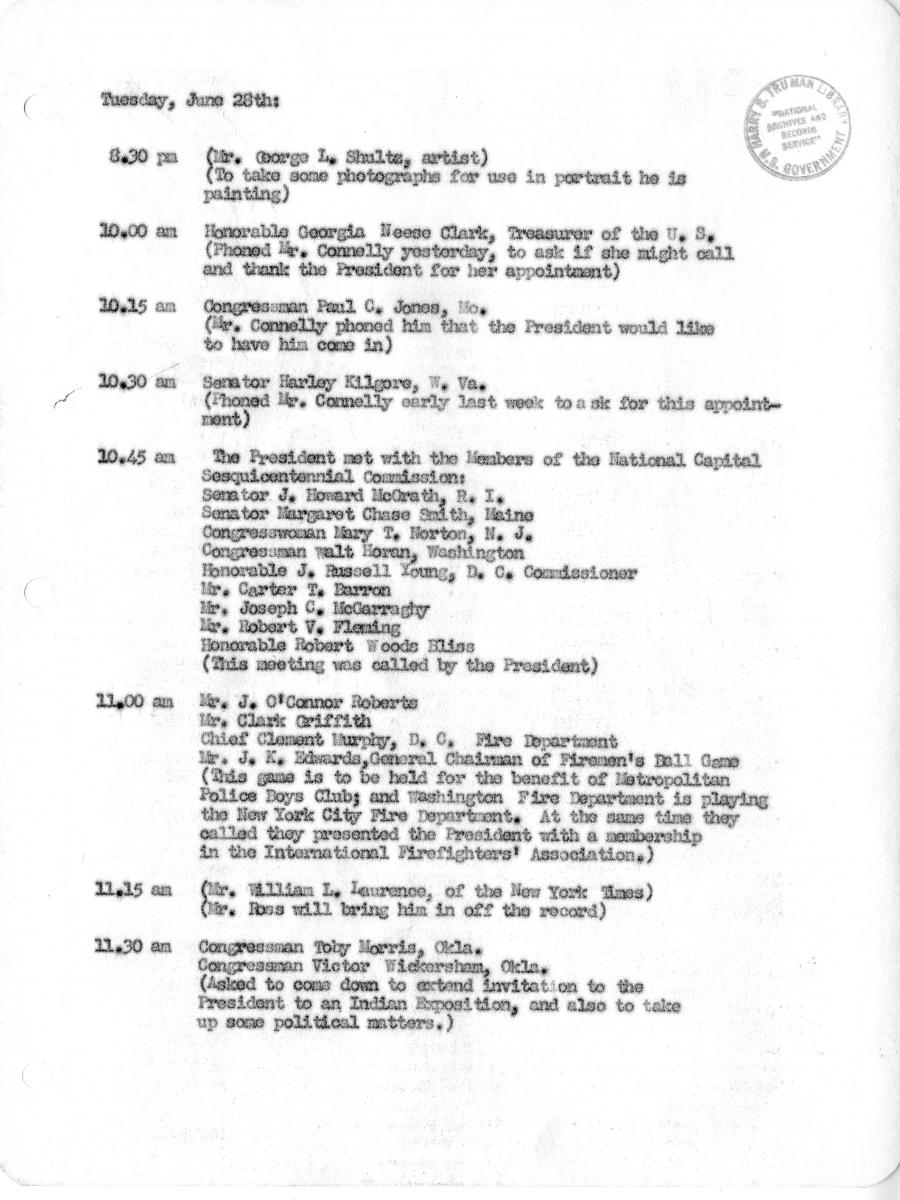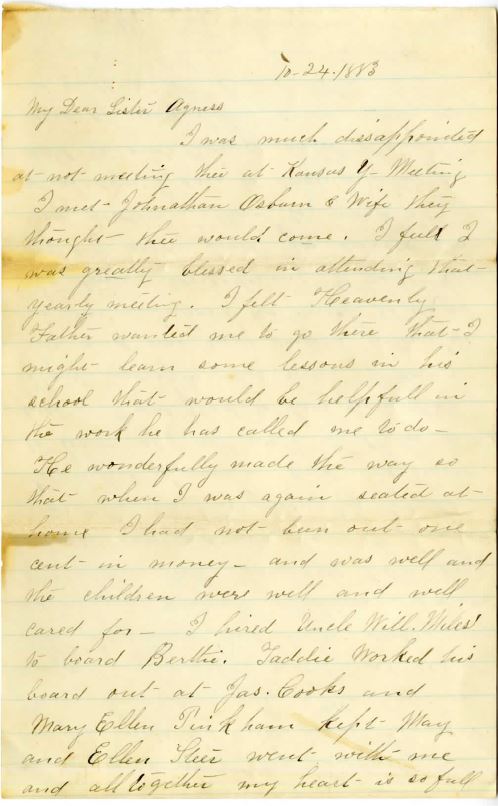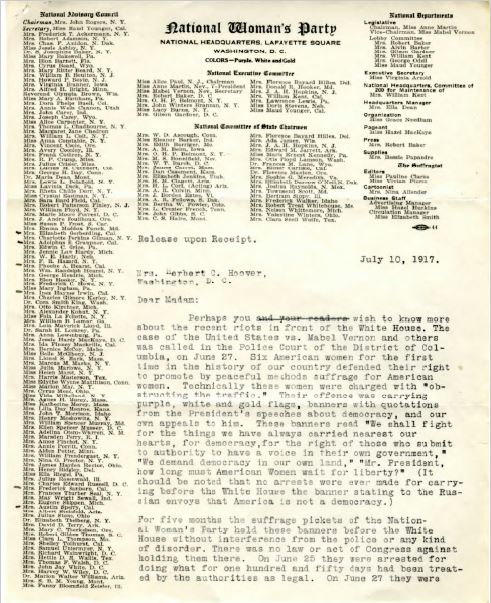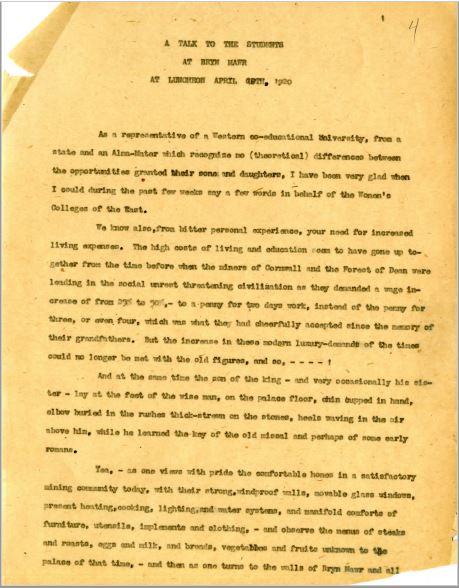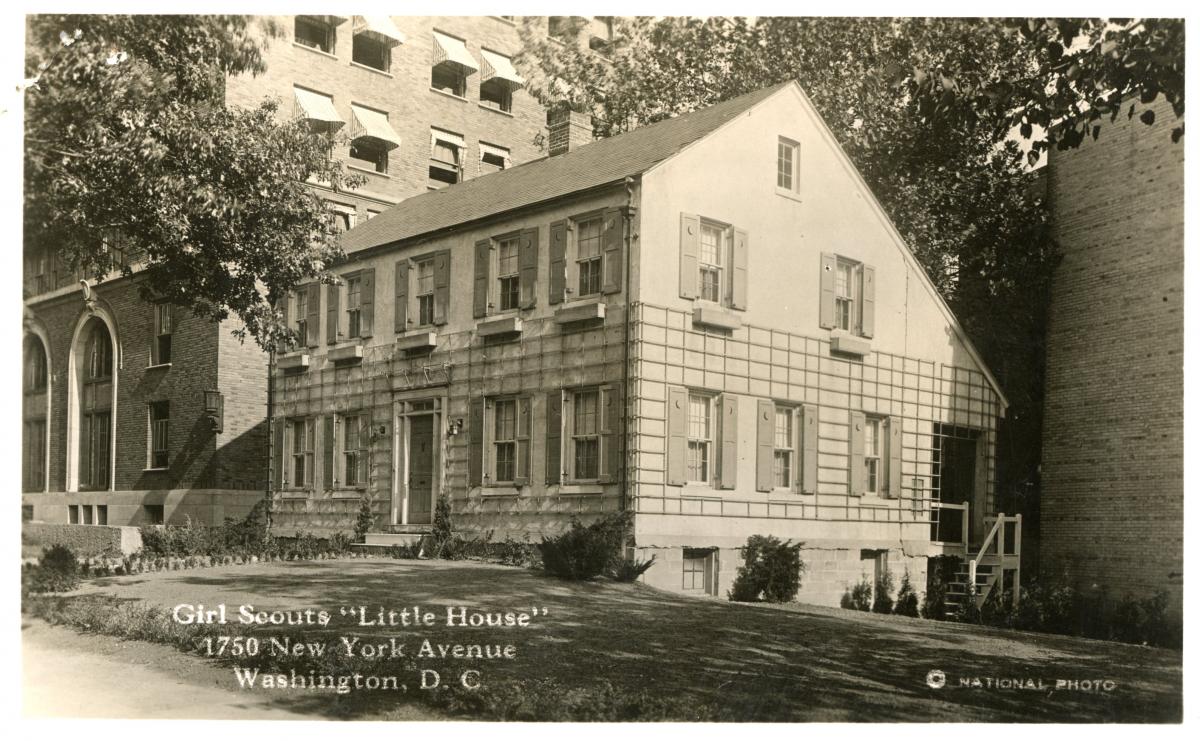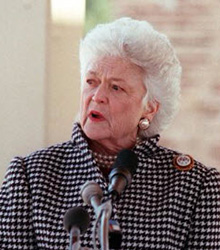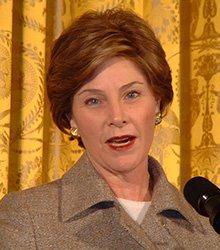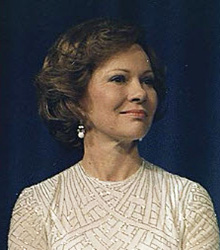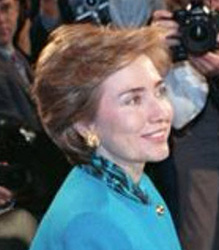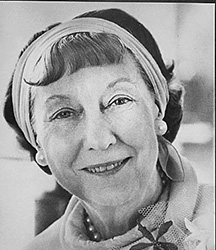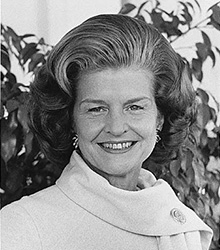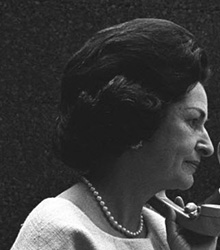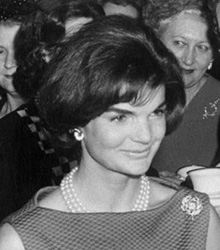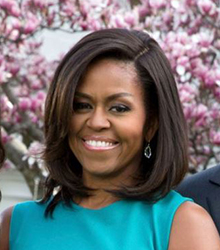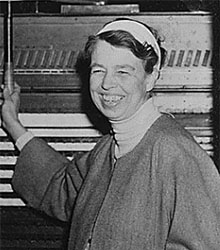
Research Topics: Notable Women
When our Constitution was written, it was silent on women. Excluded from most of the rights and privileges of citizenship, women operated in limited and rigid roles while enslaved women were excluded from all. Yet women have actively participated as citizens—organizing, marching, petitioning—since the founding of our country. The holdings of the National Archives regarding women are extensive and include documents on a wide range of subjects, illustrating the dynamic involvement of American women across the spectrum of race, ethnicity, and class to secure women’s rights.
Explore photographs, textual, and other records related to prominent advocates of women’s rights in the National Archives Catalog.
Women in Presidential Administrations
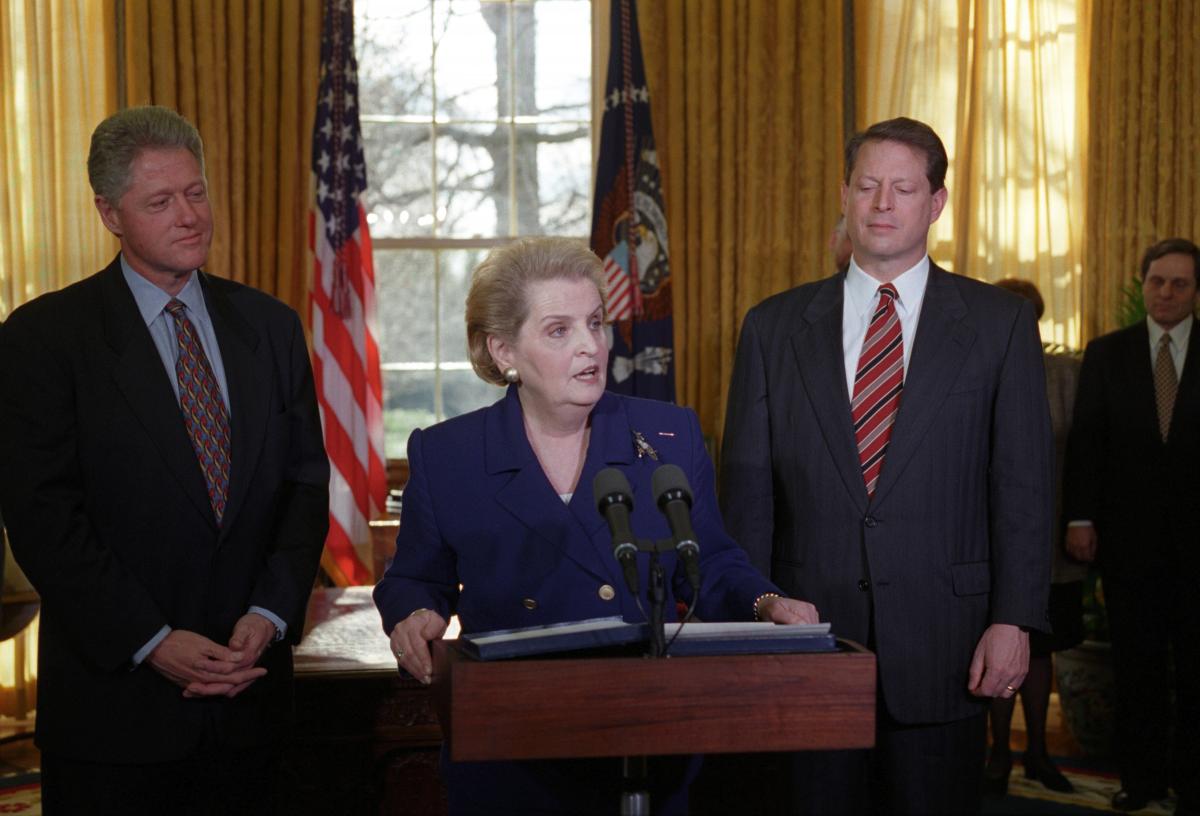
Swearing-In Ceremony for Madeleine Albright as Secretary of State, White House, January 23, 1997. Photo by Ralph Alswang
Madeleine Albright was nominated to be the first woman Secretary of State by President William Jefferson Clinton on December 5, 1996. She was confirmed by the U.S. Senate on January 22, 1997, and sworn in the next day. Albright served in the position for four years and ended her service on January 20, 2001.
See the official U.S. Department of State biography for Madeleine Korbel Albright

Letter from Madeleine Albright to President Clinton
The handwritten letter she sent to President Clinton in July 1997, roughly six months after becoming Secretary of State, describes how her visit to her birthplace of Prague, Czechoslovakia was particularly moving. Secretary Albright thanks Clinton for letting her “share in righting wrongs in Central and Eastern Europe” and expresses her gratitude for having been given the “privilege of representing the most remarkable country in the world.” The press release from the U.S. Department of State with the official transcription of her speech was included with the correspondence.
Toward the end of his administration and her tenure as Secretary of State, Albright sent President Clinton a memo summarizing her preliminary conclusions from the “White House Conference on Culture and Diplomacy.” She reports that the December 2000 conference was well received. Secretary Albright states that in her closing remarks, she stressed that the conference “signals a determination to put cultural understanding and exchange at the center of our diplomatic efforts.”
-from the William J. Clinton Presidential Library and Museum
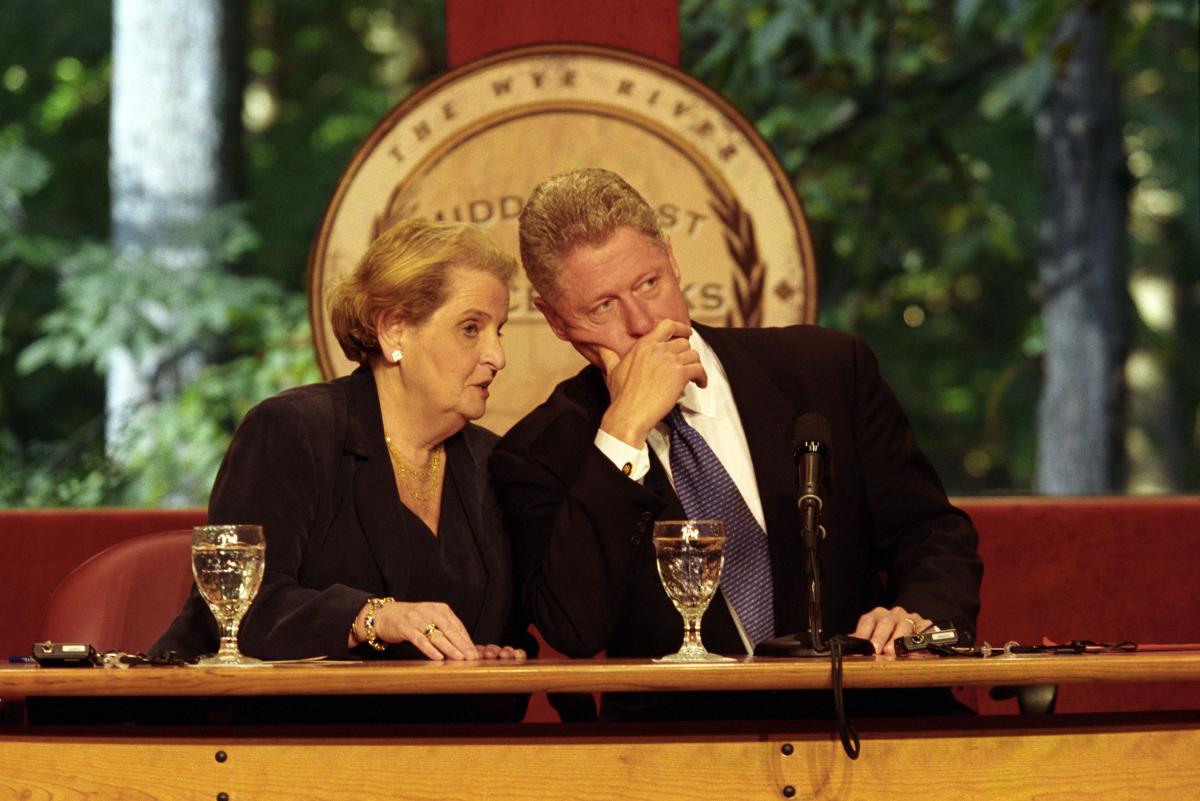
President Clinton and Secretary of State Madeleine Albright Talk During the Wye River Plenary Session near Queenstown, Maryland. October 15, 1998. Photo by Sharon Farmer.
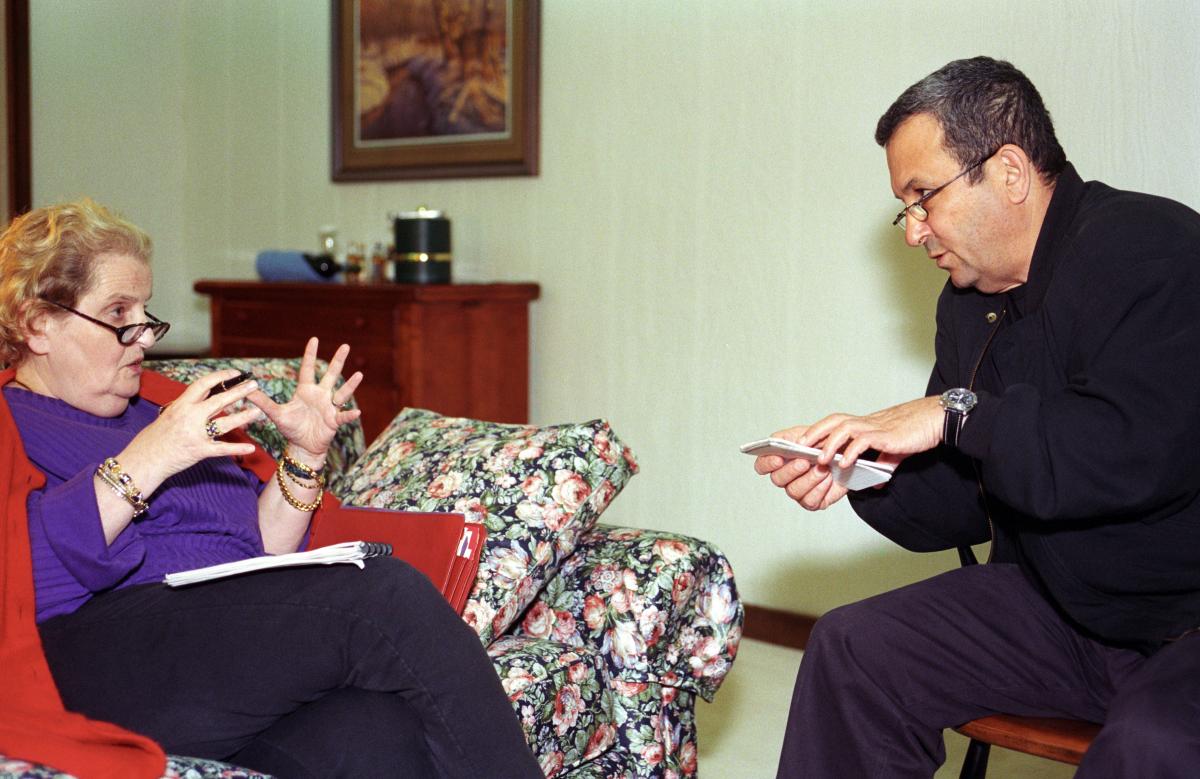
Secretary of State Madeleine Albright and Prime Minister Ehud Barak of Israel Talk During Middle East Negotiations at Camp David. July 13, 2000. Photo by David Scull.
Eugenie Anderson, of Minnesota, was the first woman appointed chief of mission at the Ambassador level in United States history. She helped found the Minnesota Democratic-Farmer-Labor Party in 1944. She remained active in Democratic politics, and through the support of India Edwards, the head of the Women's Division of the Democratic National Committee, and Senator Hubert Humphrey, President Harry S. Truman appointed her Ambassador to Denmark in 1949. Among her accomplishments as Ambassador was her work to encourage Denmark's contributions to the North Atlantic Treaty Organization.
-from the Harry S. Truman Presidential Library and Museum
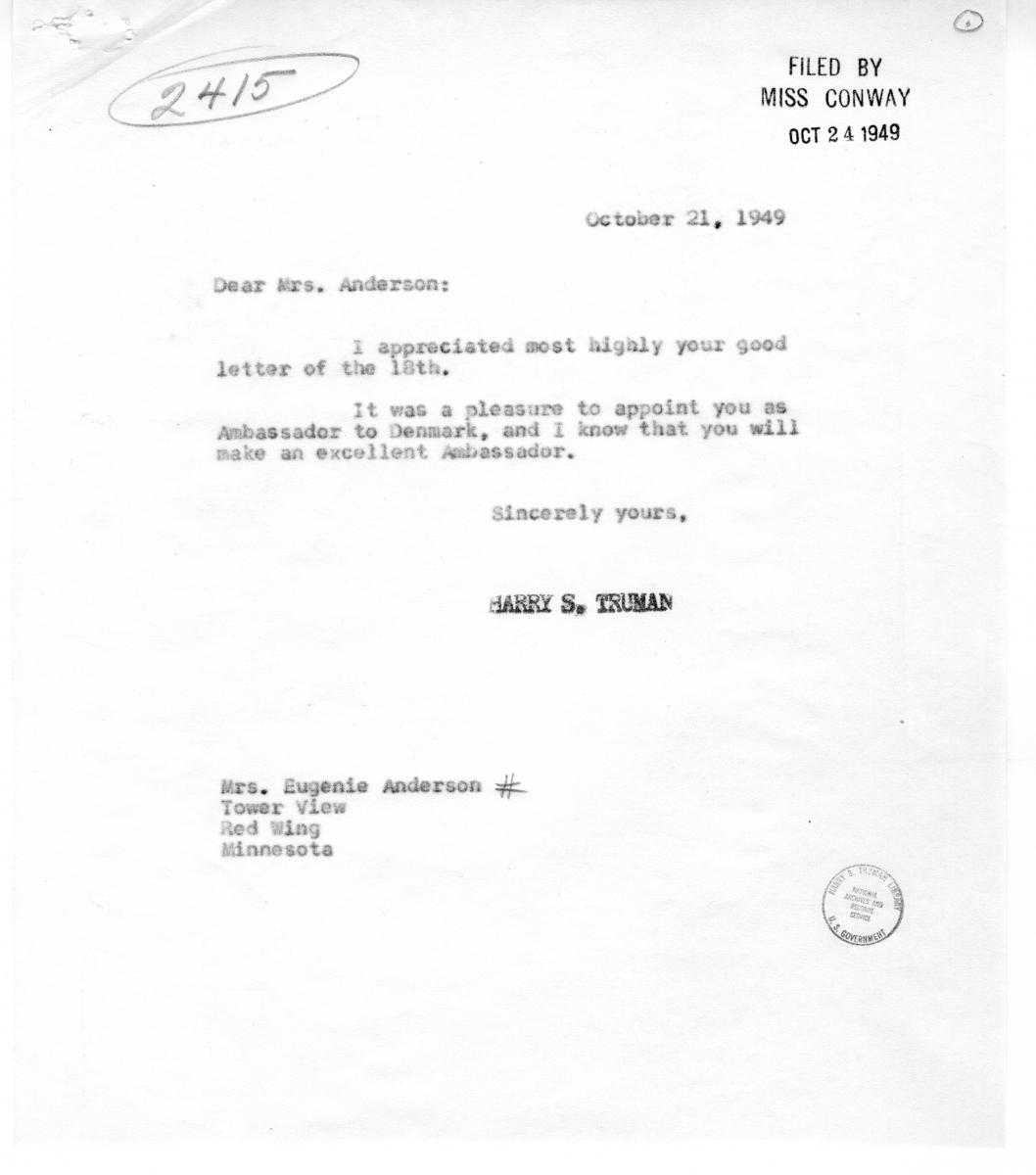
Correspondence Between President Harry S. Truman and Eugenie Anderson, with Attachments and Related Material

Correspondence Between President Harry S. Truman and India Edwards, with Attachment
Elaine Chao, then of California, was first nominated to be Deputy Secretary of Transportation in April of 1989. In September of 1991 she was nominated to become the 12 th Director of the Peace Corps. She was the first Asian-American to fill either of these roles. Secretary Chao later served as Secretary of Labor for the George W. Bush administration and is the current Secretary of Transportation.-from the George Bush Presidential Library
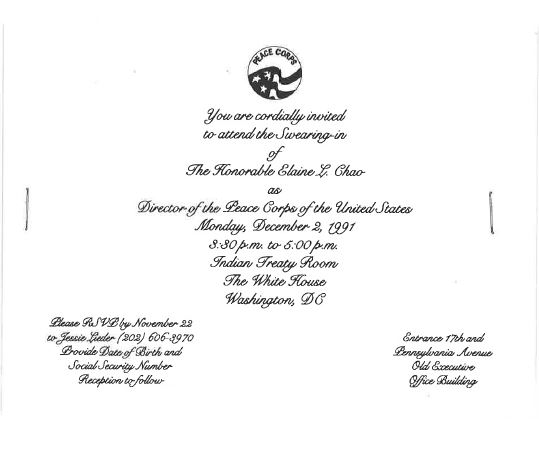
[Chao, Elaine] Invitation to Her Swearing-In Ceremony on December 2, 1991
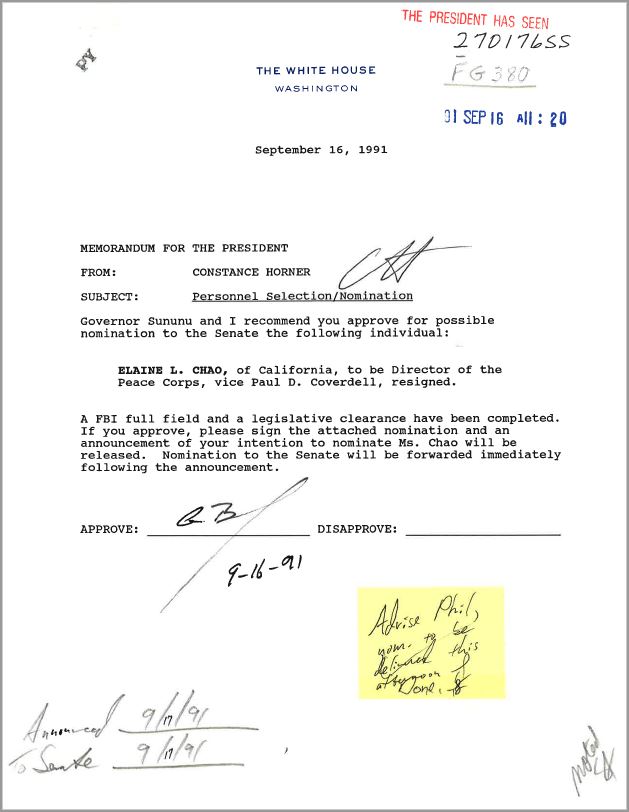
Memo From Constance Horner to President Bush Re: Personnel Selection/Nomination [Chao, Elaine]
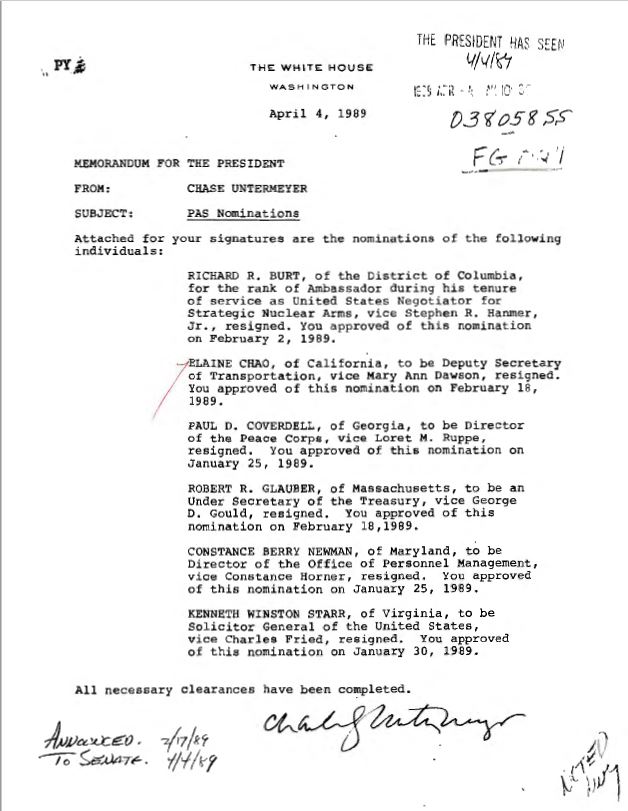
Nomination of Elaine Chao to be Deputy Secretary of Transportation
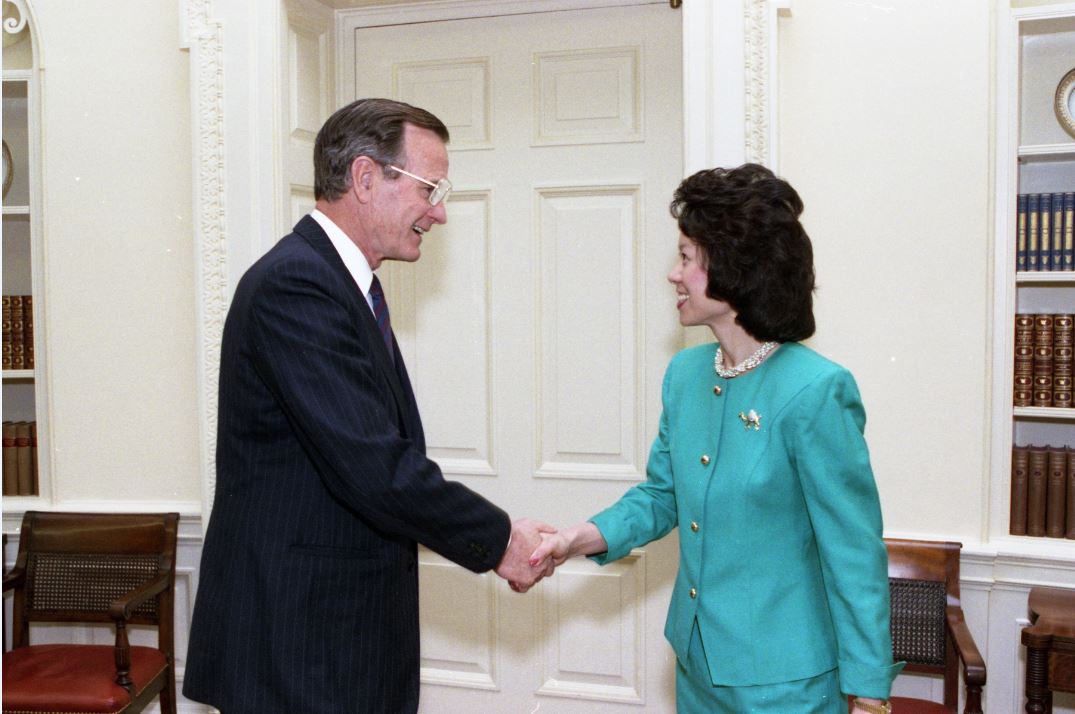
President Bush greets Elaine Chao and her family in the Oval Office. 16 May 1989. Photo Credit: George Bush Presidential Library and Museum
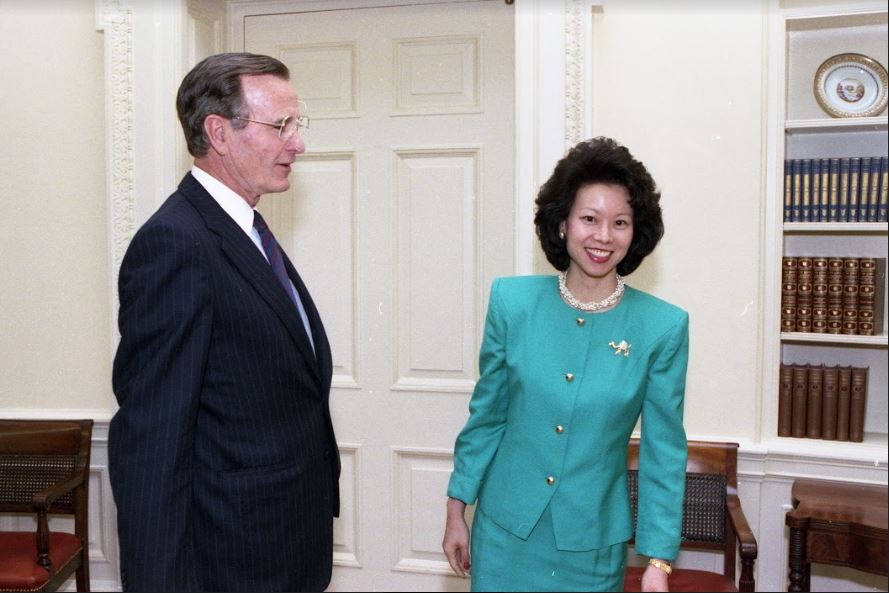
President Bush greets Elaine Chao and her family in the Oval Office, 16 May 1989. Photo Credit: George Bush Presidential Library and Museum
Georgia Neese Clark, of Kansas, was the first woman named as Treasurer of the United States. She majored in economics at Washburn University, and worked at her father's bank in Richland, Kansas. After her father's death, she became President of the bank and inherited other businesses owned by her father. She served as a Democratic National Committeewoman from Kansas, and was a strong supporter of President Truman. That support, and the support from India Edwards, the head of the Women's Division of the Democratic National Committee, helped Ms. Clark receive the nomination from President Truman for Treasurer of the United States. Ms. Clark remained a close family friend of the Trumans in their post-presidential years. Since Ms. Clark, every Treasurer of the United States has been a woman.
-from the Harry S. Truman Presidential Library and Museum
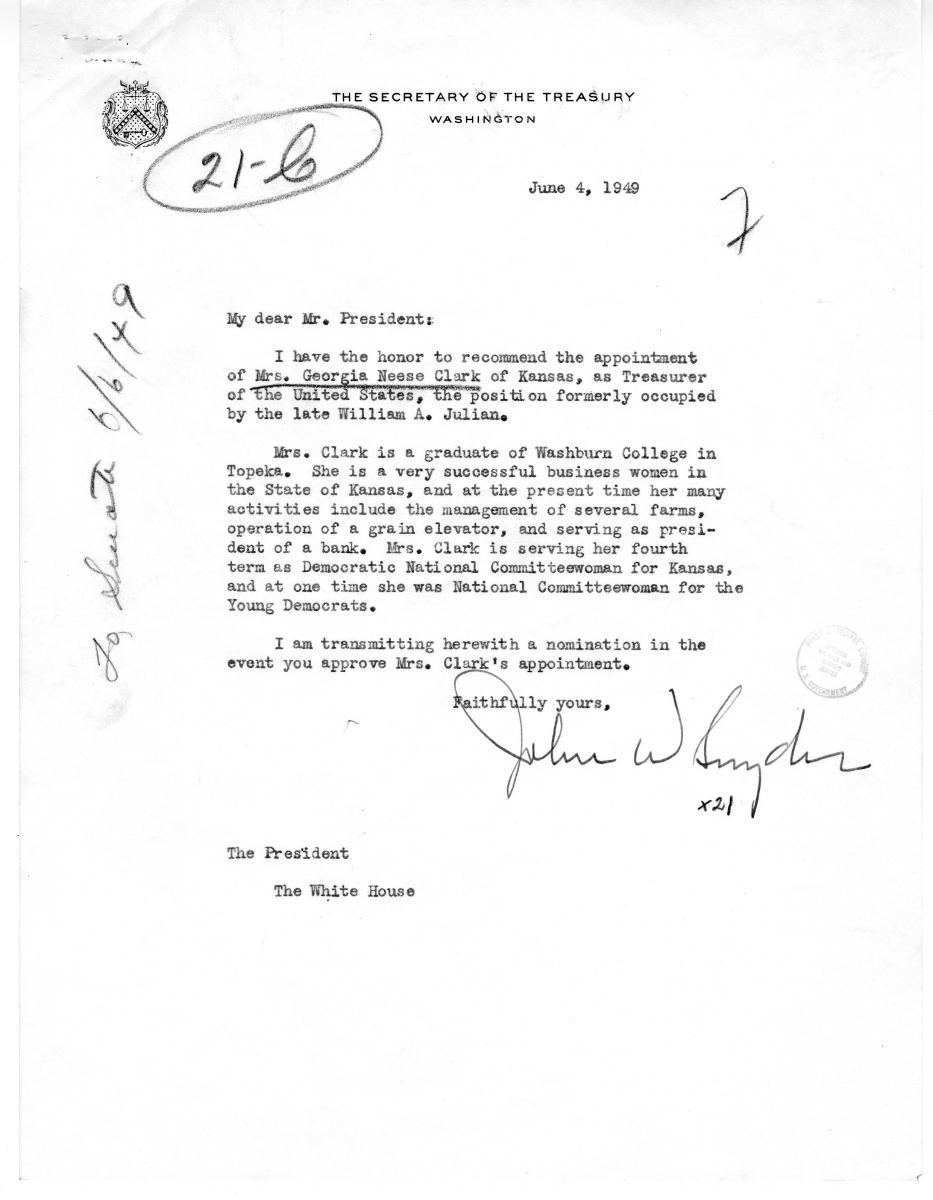
Memorandum from Secretary of the Treasury John Snyder to President Harry S. Truman with Attachments
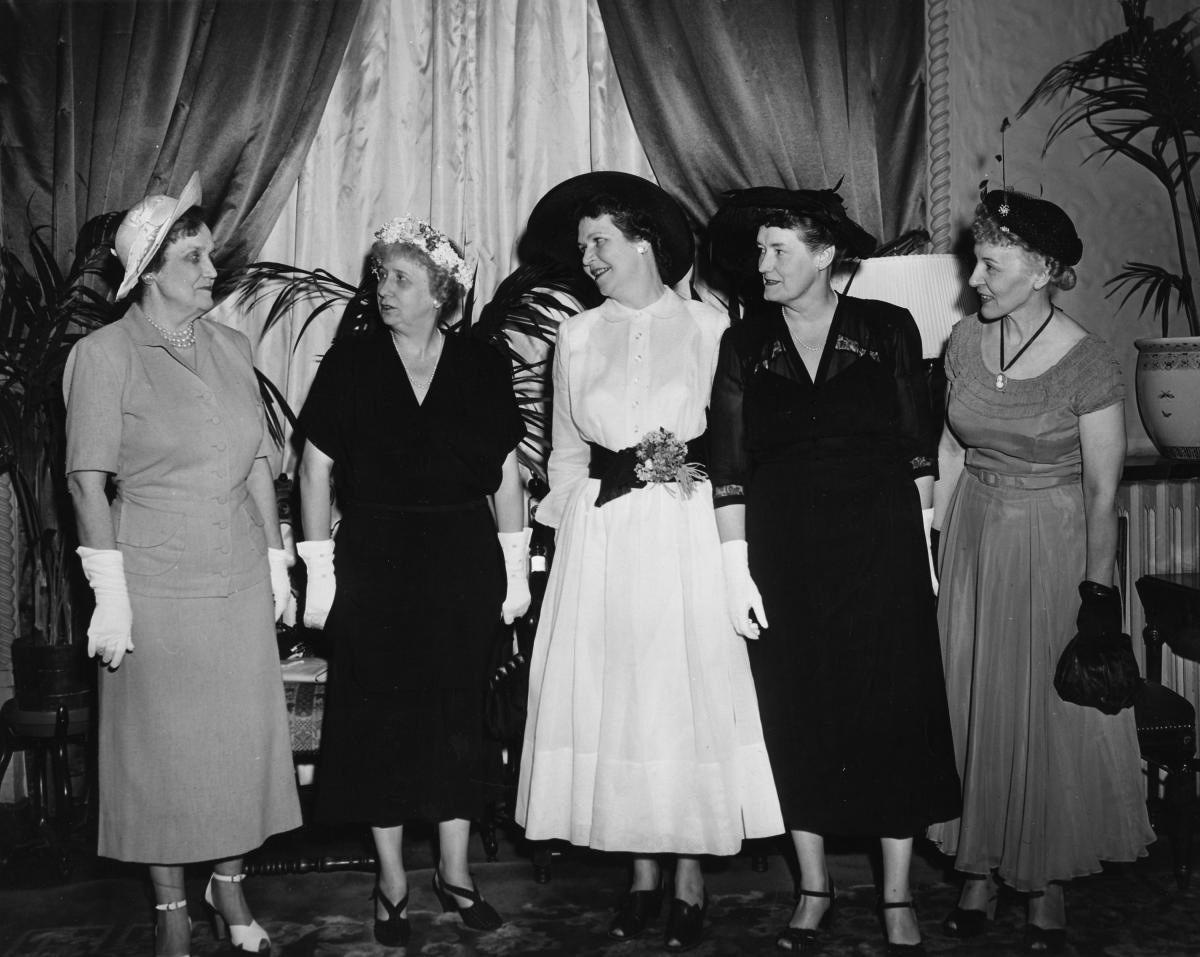
First Lady Mrs. Bess W. Truman with various women Democratic Party leaders. From left to right: United States Ambassador to Luxembourg Perle Mesta, Mrs. Truman, Treasurer of the United States Mrs. Georgia Neese Clark, Democratic National Committee Vice-Chair India Edwards, and Mrs. Gladys Avery Tillett. ca.1950
Jacqueline Cochran and the Women’s Airforce Service Pilots (WASPs)
In 1942, following U.S. entry into World War II, the Air Force recognized the need for additional pilots. Jacqueline Cochran was appointed to head a program for training women pilots. As head of the Women’s Airforce Service Pilots (WASPs) she supervised the training of over one thousand women, many of whom performed distinguished service flying experimental Air Force planes. In order to serve as a civilian pilot in the WASPs, women had to meet strict requirements. In addition to previous training as a pilot, age restrictions, citizenship, and education, they were expected to pass a flight test and physical examination. Over one thousand women became WASPs during World War II. In June 1943, H. H. Arnold, Commanding General, Army Air Forces recommended that these women be commissioned in the Army Air Force similar to male pilots so that they could “receive the same pay…allowances…rights, privileges, and benefits as their male counterparts. It wasn’t until 1977 that legislation was passed giving these women veteran status, allowing them to receive veterans benefits.
Biography
Bessie Pittman was adopted by Ira and Mary (Grant) Pittman as an infant. As a child, Bessie possessed an unusual amount of drive and ambition. Growing up the youngest of five children in a poor family in northwest Florida, she resented the limited opportunities available to her. At an early age Bessie left home and changed her name to “Jacqueline Cochran.”
After briefly studying to be a nurse, Ms. Cochran obtained a job in a beauty parlor in Pensacola, Florida. In 1932 she became a beautician in an exclusive store in New York City. Shortly thereafter, she developed her own line of cosmetics and founded a company, Jacqueline Cochran Incorporated.
Although her cosmetics business brought her widespread recognition, Ms. Cochran is chiefly remembered for her aeronautical activities. In 1932, while living in New York City, a friend offered her a ride in an airplane. Entranced by the flight, Ms. Cochran took flying lessons and made her first solo flight after only a few hours instruction.
From her earliest days as a pilot, Ms. Cochran was interested in air racing. In 1934 she entered the MacRobertson Air Race from London to Melbourne, Australia. She also entered the annual National Air Races and in 1938 became the first woman to win the prestigious Bendix Trophy. She was also active in various aeronautical organizations, particularly the National Aeronautical Association (NAA), and the Ninety-Nines, a group of professional women pilots.
By 1941 Jacqueline Cochran was one of the most famous women pilots in the United States. Keenly aware of the Nazi threat to Europe, she approached the U.S. Army Air Corps and suggested using women as ferry pilots in wartime. Initially turned down, she went to England and volunteered her services to the Royal Air Force.
In 1942, following U.S. entry into World War II, the Air Force recognized the need for additional pilots. Cochran was selected to head a program for training women pilots. As head of the Women’s Airforce Service Pilots (WASPs) she supervised the training of over one thousand women, many of whom performed distinguished service flying experimental Air Force planes.
In March 1945 she was awarded the Distinguished Service Medal.
-from the Eisenhower Presidential Library
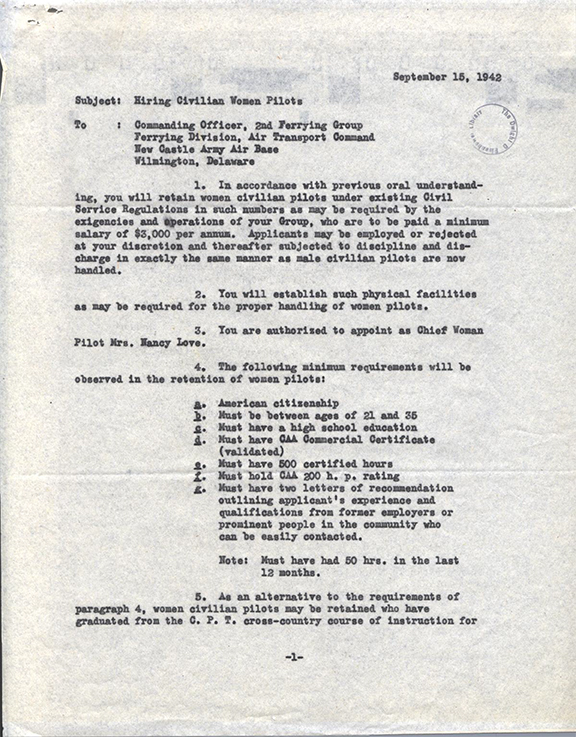
Memorandum, Hiring Civilian Women Pilots
Memo regarding Hiring Civilian Women Pilots, September 15, 1942 [Jacqueline Cochran Papers, WASP Series, Box 12, Establishment of WASP]
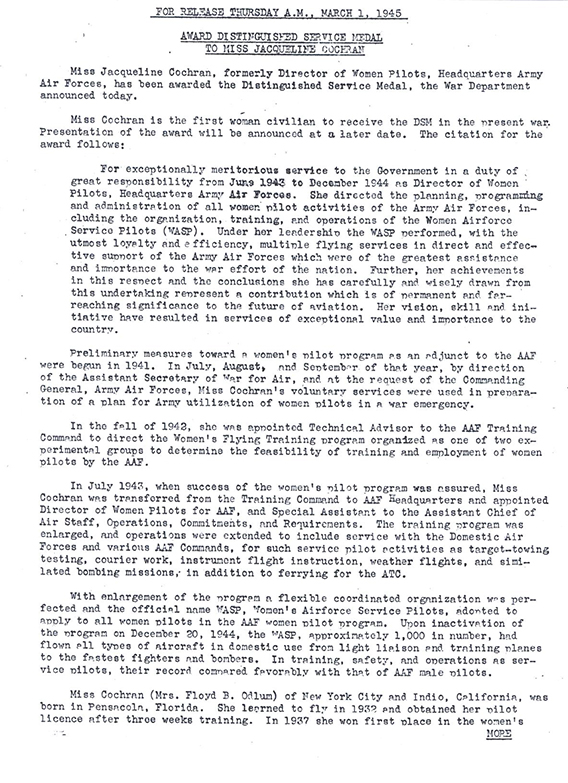
Press release regarding Distinguished Service Medal awarded to Cochran, March 1, 1945 [Jacqueline Cochran Papers, WASP Series, Box 13, Press Releases (3)]
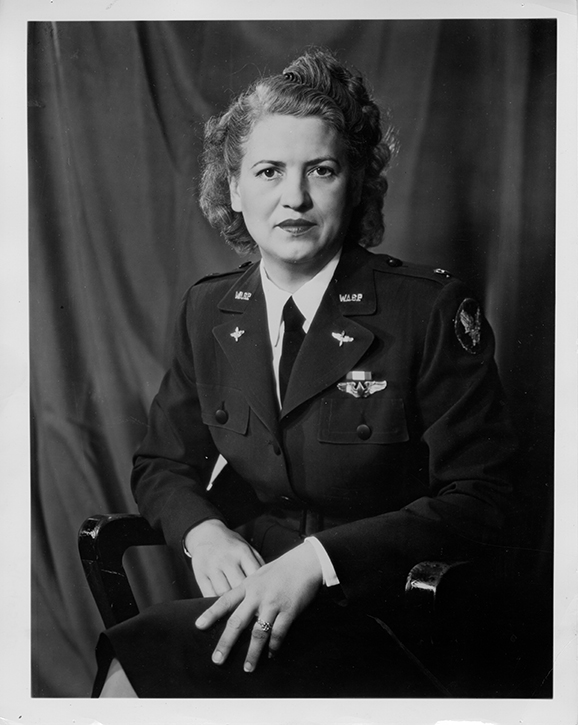
Jacqueline Cochran wearing her WASP uniform as Director of the WASPs during World War II. Eisenhower Library, 91-4-5695.
Elizabeth Hanford Dole of Kansas is one of two women that President George H.W. Bush nominated to prominent roles in his Administration on January 20, 1989. Elizabeth Dole was nominated to be the Secretary of Labor. Senator Dole was the third woman to serve as Secretary of Labor following Frances Perkins and Ann McLaughlin. She also served as Secretary of Labor under President Reagan and Commissioner of the Federal Trade Commission under President Nixon. She later served as United States Senator from North Carolina.
-from the George Bush Presidential Library
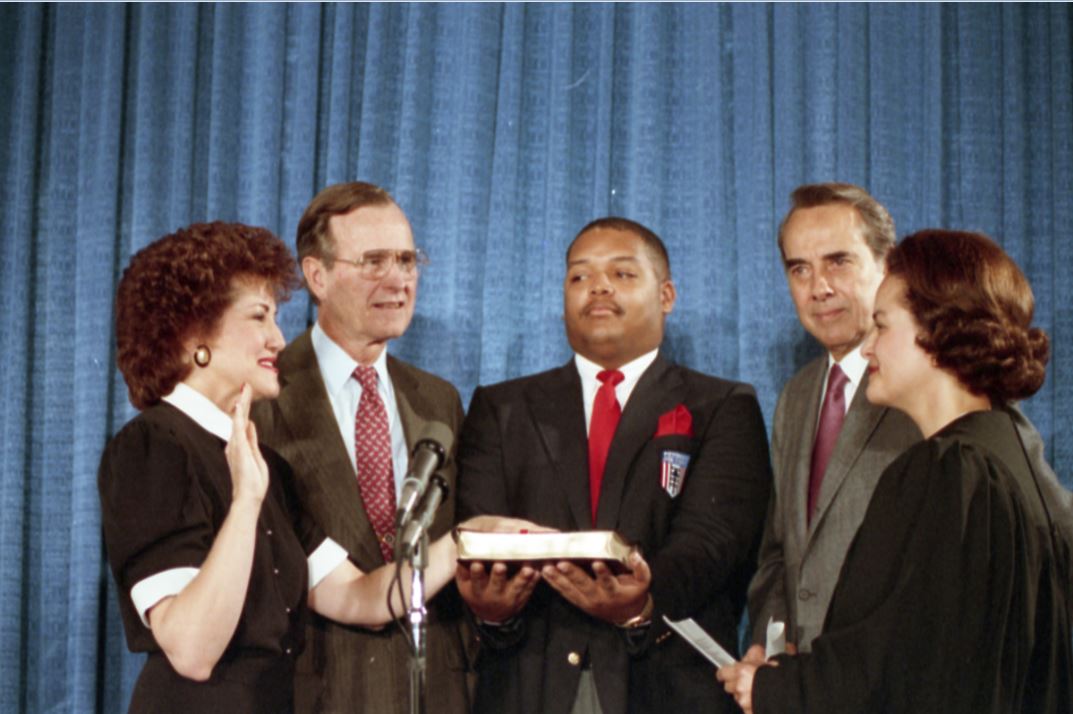
President Bush participates in the swearing-in ceremony for Elizabeth Dole as Secretary of Labor. President Bush and Senator Robert Dole look on, as Judge Judith Rogers, Chief Justice, DC Court of Appeals, administers the oath. Anthony Bond, holds the Bible, 30 January 1989. Photo Credit: George Bush Presidential Library and Museum
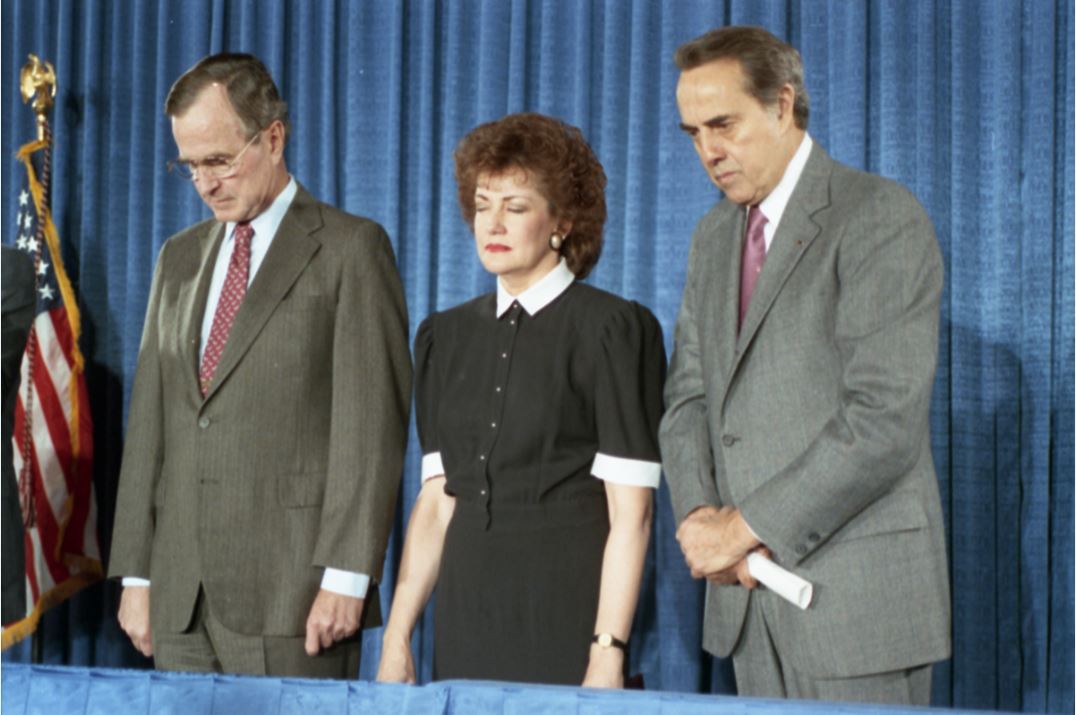
President Bush, Elizabeth Dole, and Senator Robert Dole bow their heads in prayer before Elizabeth Dole is sworn-in as Secretary of Labor. 30 January 1989. Photo Credit: George Bush Presidential Library and Museum
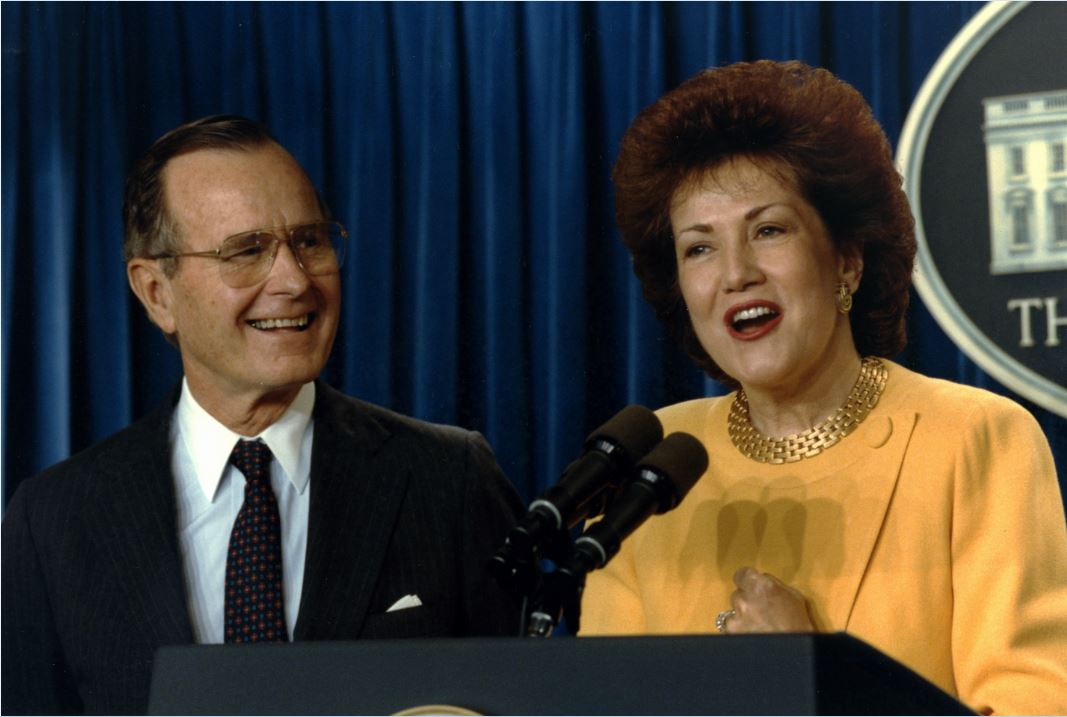
President Bush watches Secretary of Labor at the podium in the Press Briefing Room after they announce Secretary Dole’s resignation as Secretary of Labor. 24 October 1990. Photo Credit: George Bush Presidential Library and Museum
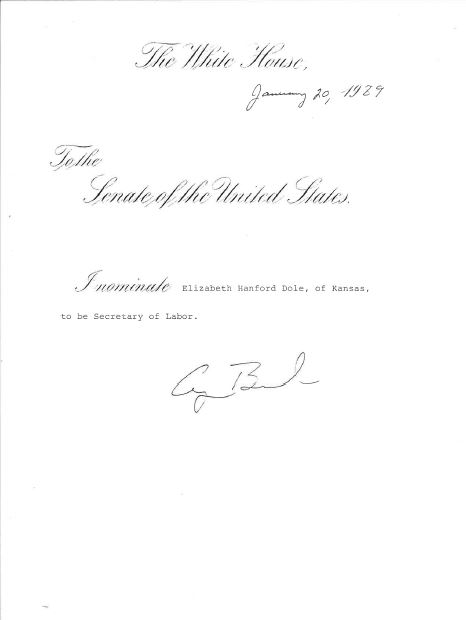
Nominations to the Senate for Elizabeth Hanford Dole and Carla Anderson Hills
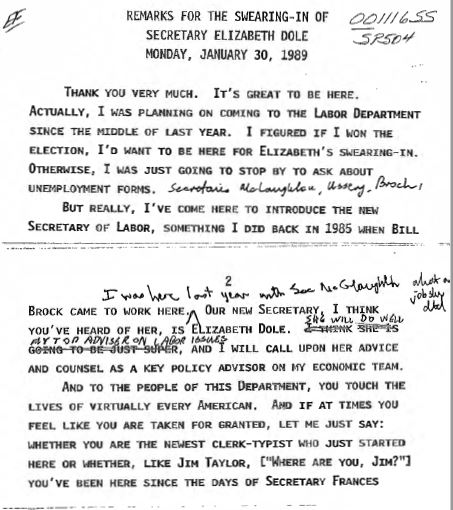
Presidential Remarks: Swearing-In of Secretary Elizabeth Dole, Department of Labor, D.C. Jan 30, 1989
Ruth Bader Ginsburg was President William Jefferson Clinton’s first nominee to the Supreme Court and the second woman appointed to the court. President Clinton nominated Ginsburg to the court on June 14, 1993. The Senate confirmed her by a 96 to 3 vote on August 3, 1993 and she took her Oath of Office on August 10, 1993. She is often referred to as the legal architect of the modern women’s movement. Her distinguished career won her acclaim from esteemed legal figures and institutions. In 2002, Ginsburg was inducted into the National Women's Hall of Fame.
-from the William J. Clinton Presidential Library and Museum
See the official U.S. Supreme Court biography for Ruth Bader Ginsburg
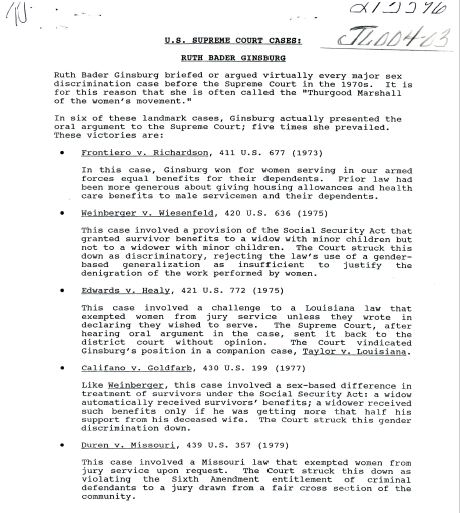
United States Supreme Court Cases and Fact Sheet: Ruth Bader Ginsburg 1993
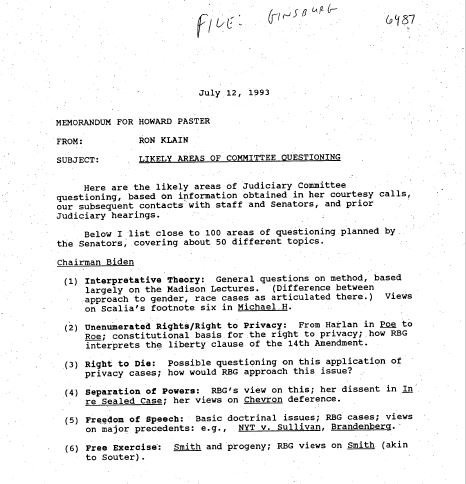
Memo from Ron Klain to Howard Paster re: Likely Areas of Committee Questioning 7/12/1993
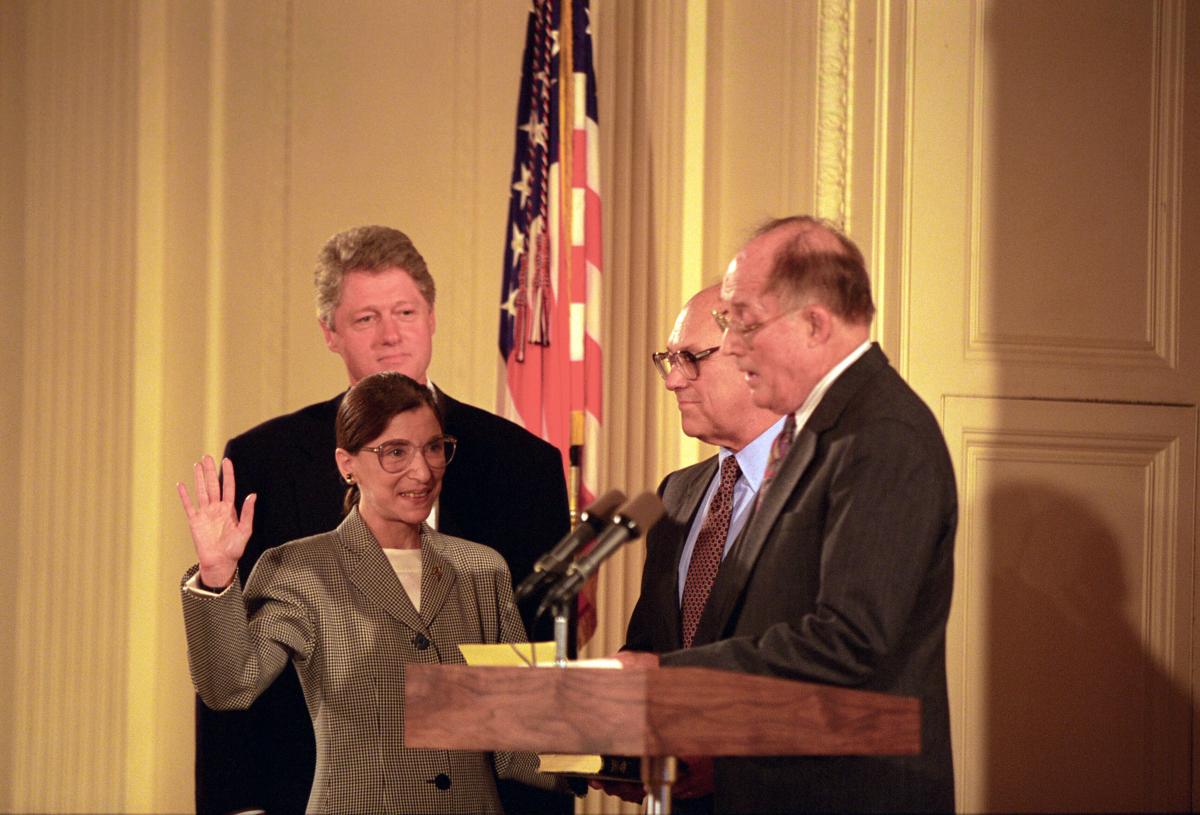
Chief Justice William Rehnquist Administers the Oath of Office to Judge Ruth Bader Ginsburg as Associate Supreme Court Justice at the White House on August 10, 1993. Photo by Ralph Alswang.
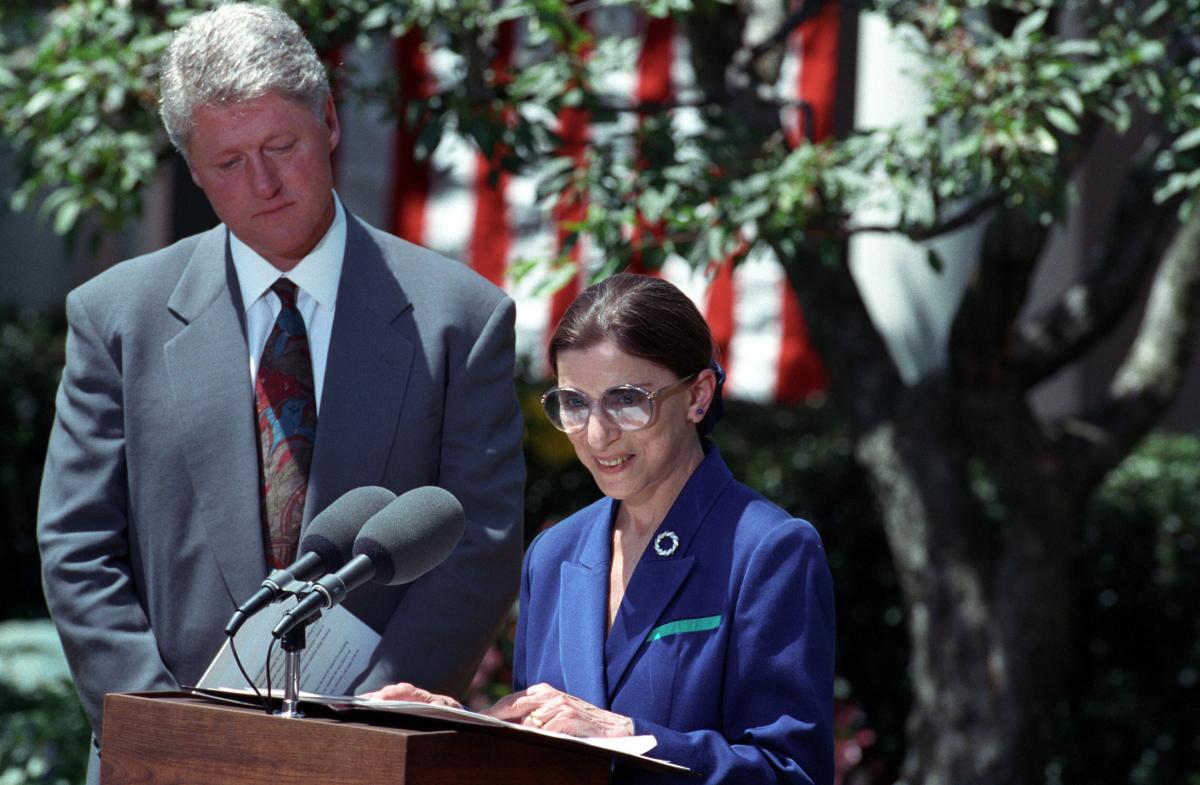
Announcement of Ruth Bader Ginsburg as Nominee for Associate Supreme Court Justice at the White House on June 14, 1993. Photo by Sharon Farmer.
President George H.W. Bush nominated Carla Anderson Hills of California to be the US Trade Representative on January 20, 1989. Ambassador Hills was the first woman to serve as US Trade Representative after serving as President Ford’s Secretary of Housing and Urban Development. She is a Chairman Emeritus of the Council on Foreign Relations and is the Chair and Chief Executive Officer of Hills and Company International Consultants.
-from the George Bush Presidential Library
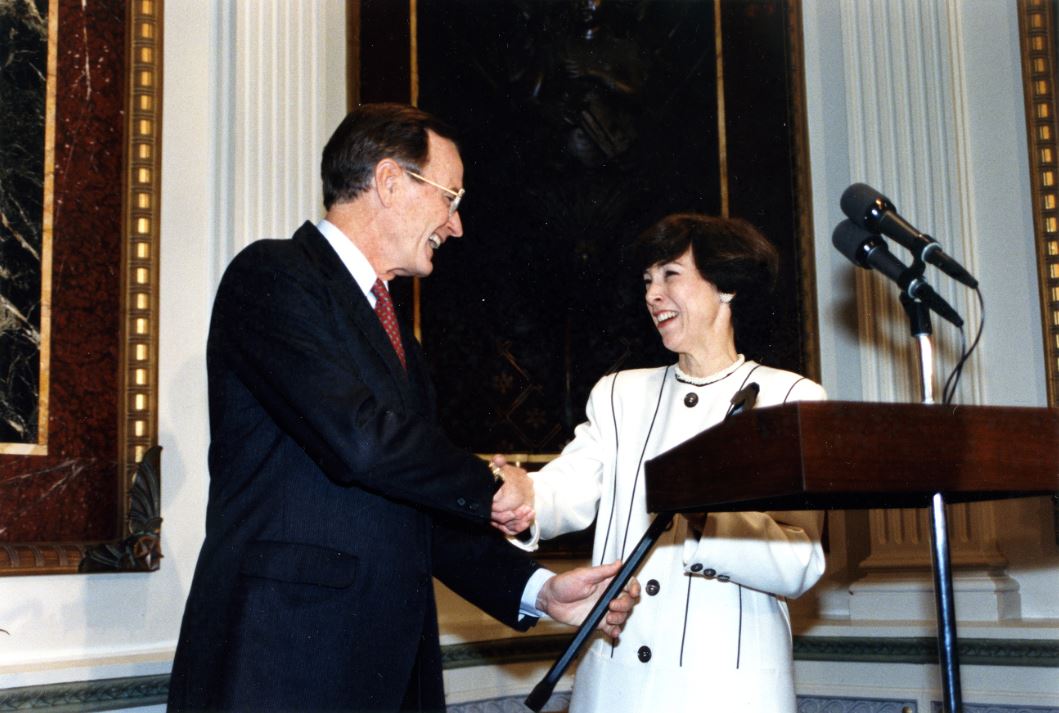
President Bush attends the swearing-in ceremony for Carla Hills, U.S. Trade Representative. Supreme Court Justice Antonin Scalia performs the ceremony. 06 February 1989. Photo Credit: George Bush Presidential Library and Museum
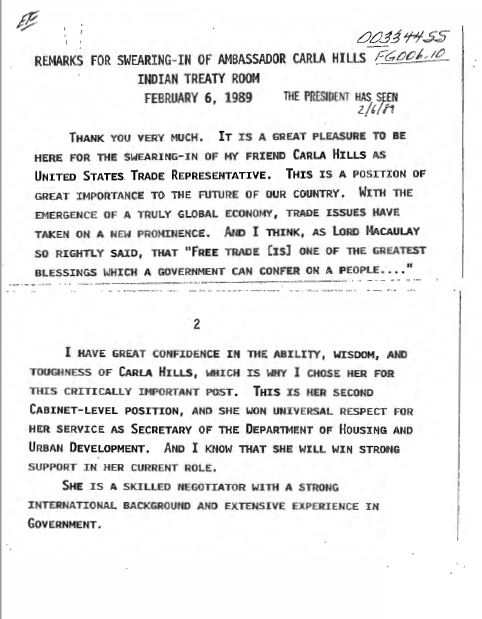
Presidential Remarks: Swearing-In of Ambassador Carla Hills as United States Trade Representative, February 6, 1989
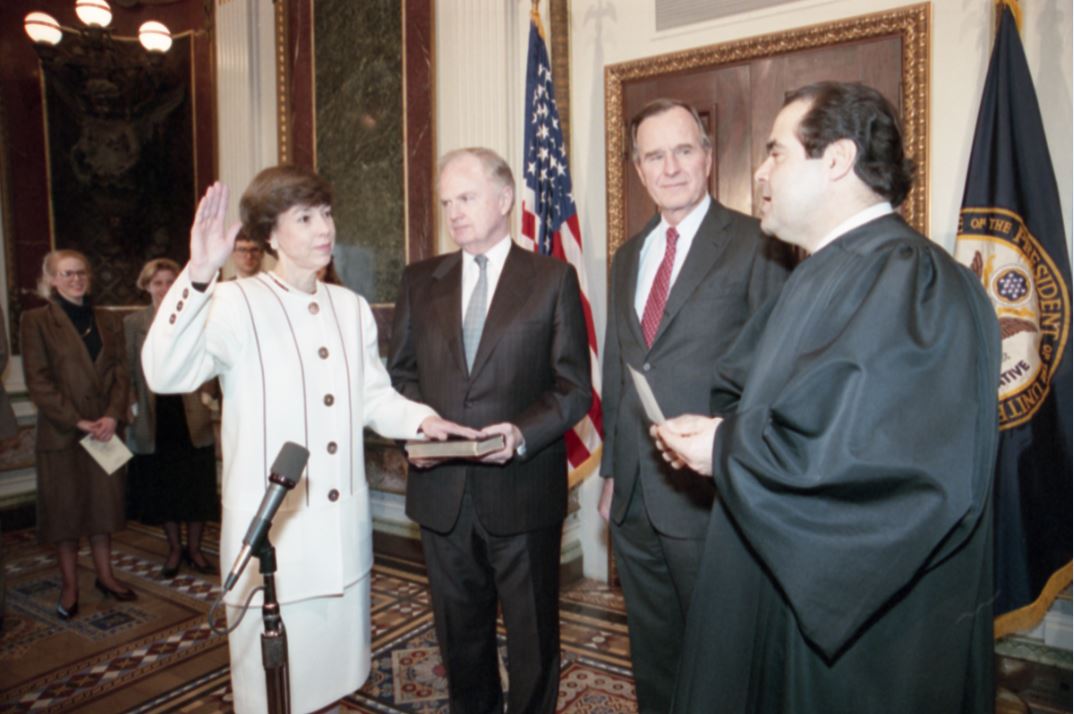
President Bush attends the swearing-in ceremony for Carla Hills, U.S. Trade Representative. Supreme Court Justice Antonin Scalia performs the ceremony, 06 February 1989. Photo Credit: George Bush Presidential Library and Museum
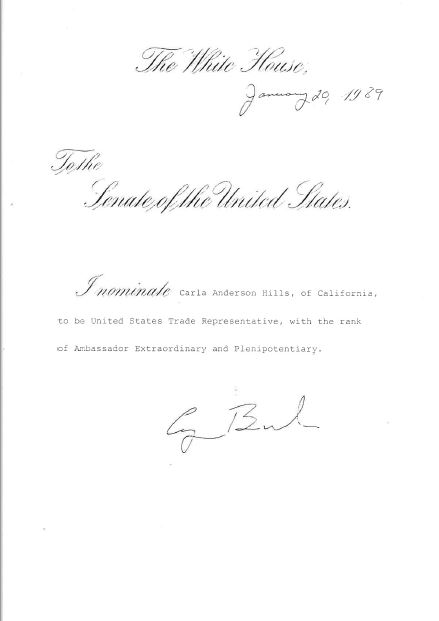
Nominations to the Senate for Elizabeth Hanford Dole and Carla Anderson Hills
Oveta Culp Hobby (1905 – 1995) began her public service career as Parliamentarian of the Texas House of Representatives in 1926. Five years later, she began working at the Houston Post. When the United States entered World War II, she served as chief of the Women’s Interest Section of the War Department Bureau of Public Relations. Shortly thereafter, she was appointed director of the Women’s Auxiliary Army Corps. In 1943 Hobby was commissioned as a Colonel and served as director of the WACs from 1943 until 1945.
President Eisenhower selected Hobby as his first Secretary of Health, Education and Welfare when he created the new department in 1953. She was only the second woman to serve in a presidential cabinet. Eisenhower supported women’s active participation in government. A 1959 report by the Women’s Division of the Republican National Committee stated, “President Eisenhower…has appointed more women to high-level positions than any other Chief Executive in the nation’s history.”
-from the Eisenhower Presidential Library
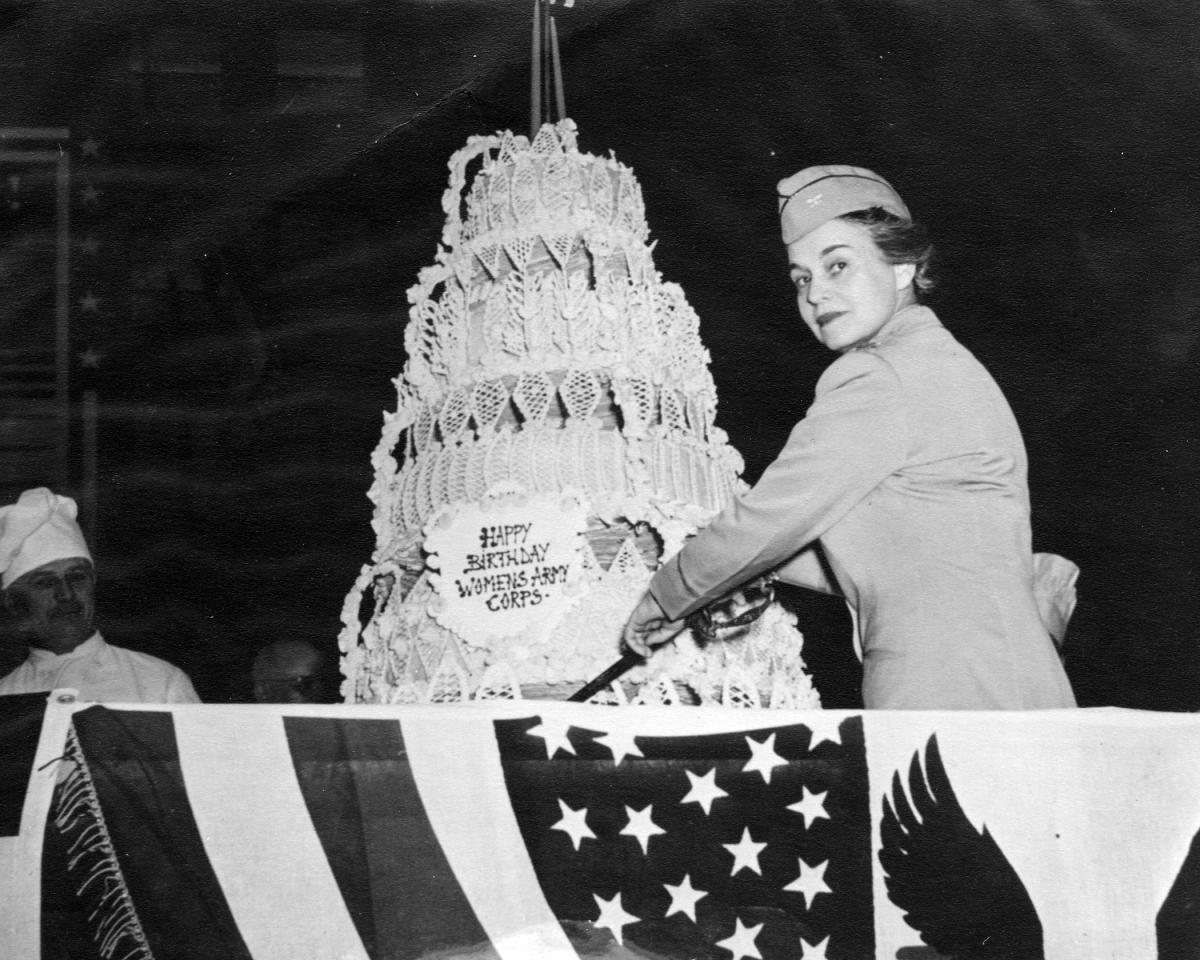
Mrs. Oveta Culp Hobby cuts the cake for the Women’s Army Corps birthday celebration in New York City. 1945

Mrs. Oveta Culp Hobby is sworn in as the first Director of the Women's Army Corps by Major General Myron C. Cramer, Army Judge Advocate General, as Chief of Staff General George C. Marshall and Secretary of War Henry L. Stimson look on. Washington, DC. May 16, 1942
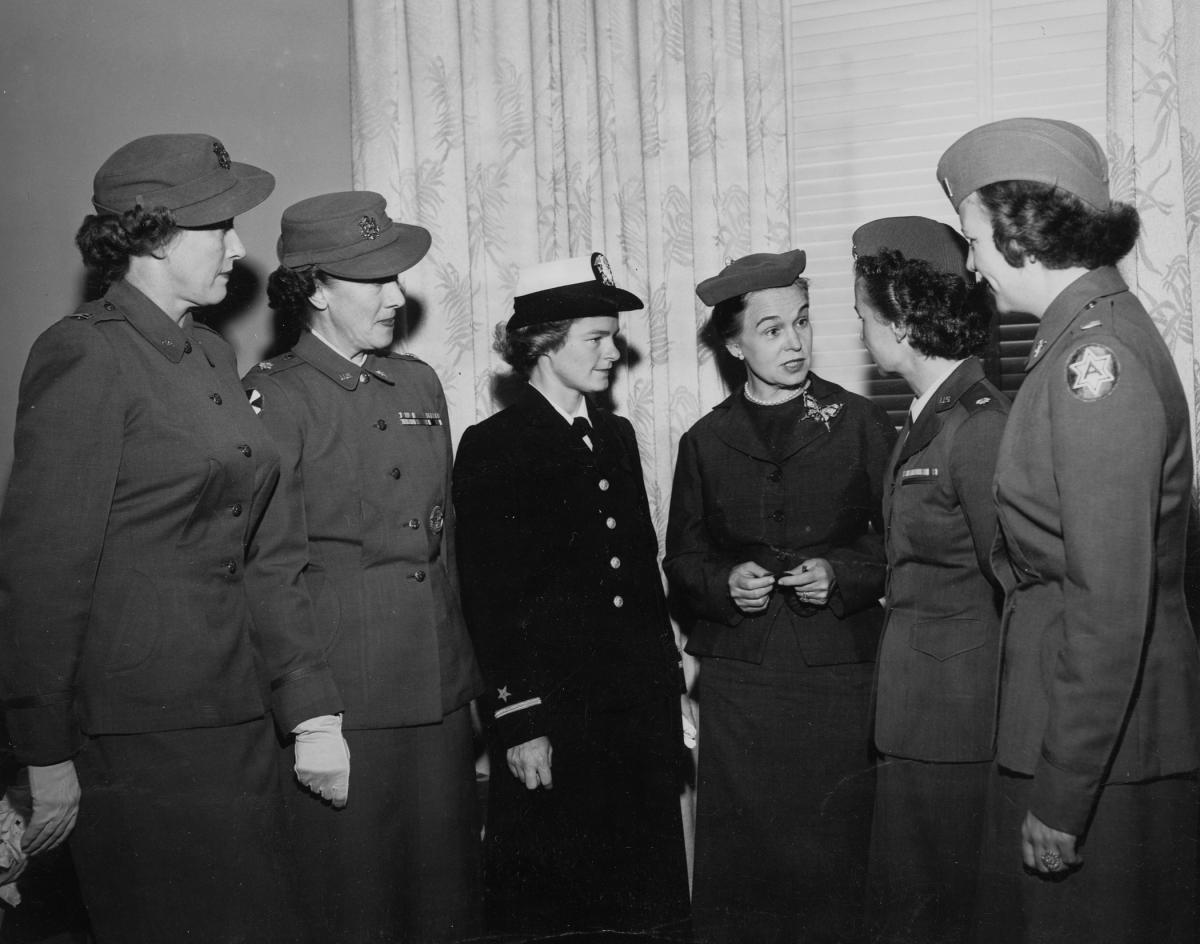
Women officers of the Armed Forces in the San Francisco Bay Area paid a courtesy call on Mrs. Oveta Culp Hobby at the Palace Hotel. Shown are: L to R Captain Gertude Murray, Major Harriet N. Moses, Ensign Susie Brossy, Hobby, Lt. Colonel Kathleen McClure, and 1st Lt. Betty Lou Simson. September 1, 1953

Mrs. Oveta Culp Hobby is sworn in as the first Secretary of Health, Education and Welfare in a ceremony at the White House. April 11, 1953
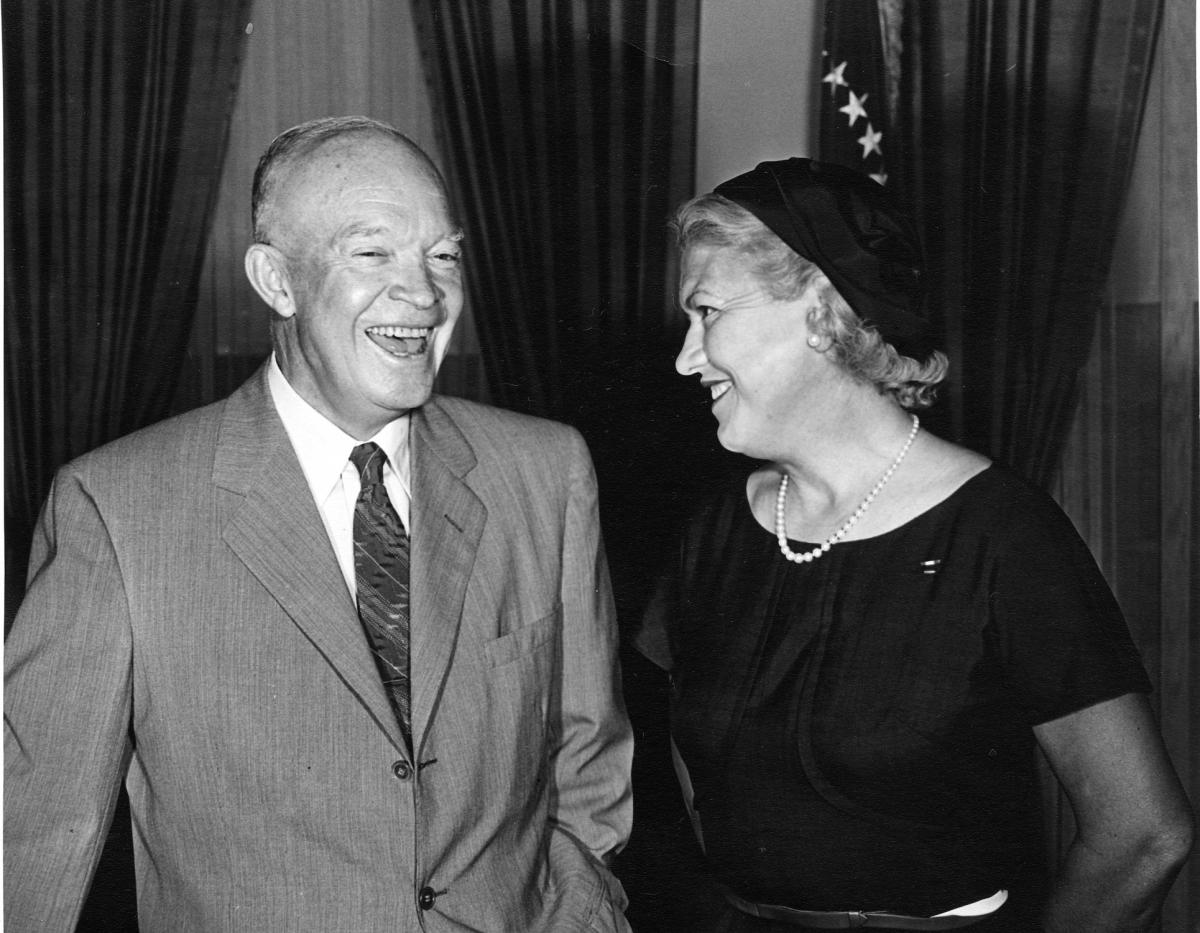
President Eisenhower receives Jacqueline Cochran, aviator and personal friend. The meeting took place in the President's Office at the White House. August 11, 1956

Bertha Adkins Papers. "September 13, 1956. The Farm." Probably taken at the Republican Kick-Off Event at Gettysburg.
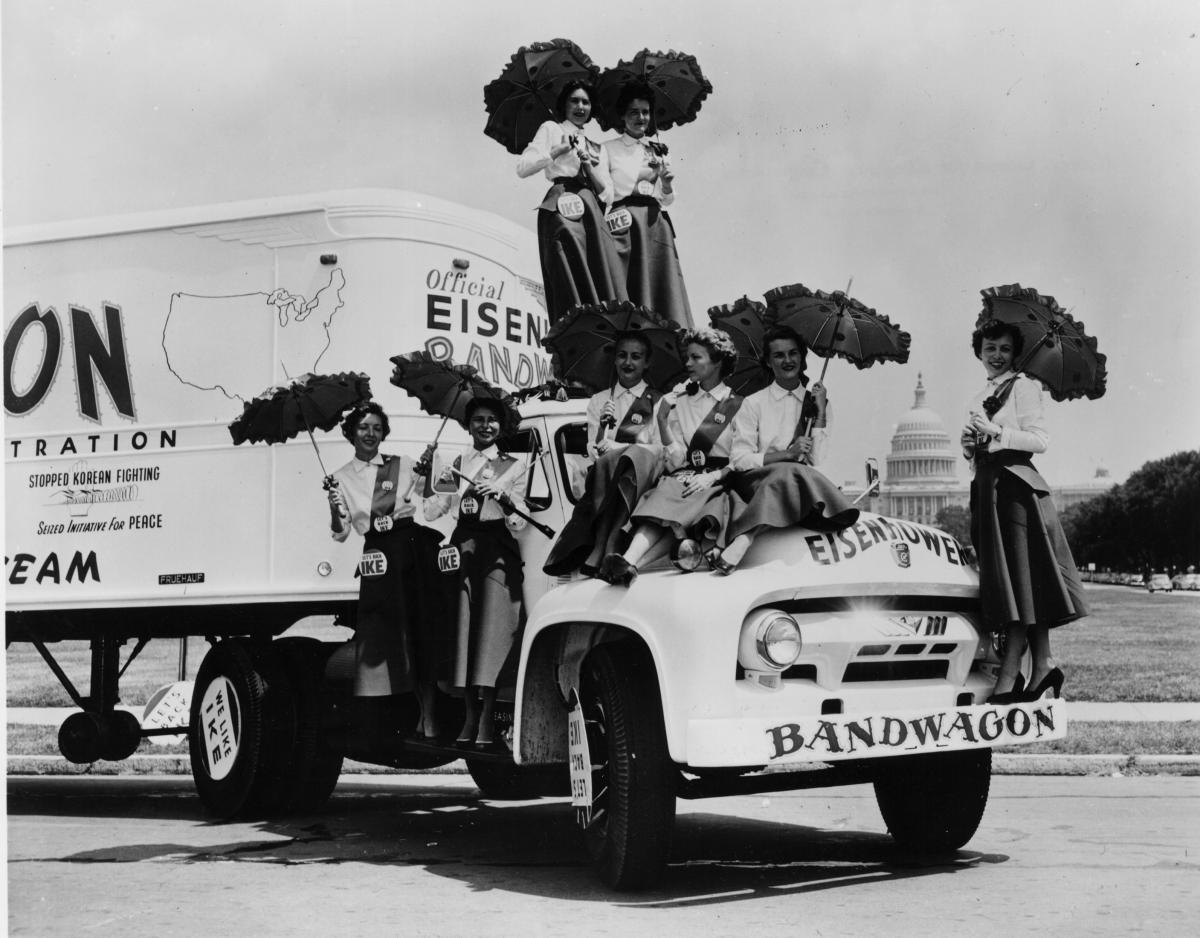
Langhorne Washburn Papers. Philadelphia Ike Girls pose on the official Citizens for Eisenhower Bandwagon as it leaves Washington, D.C. for a nationwide tour promoting various Republican congressional candidates. October 17, 1954.
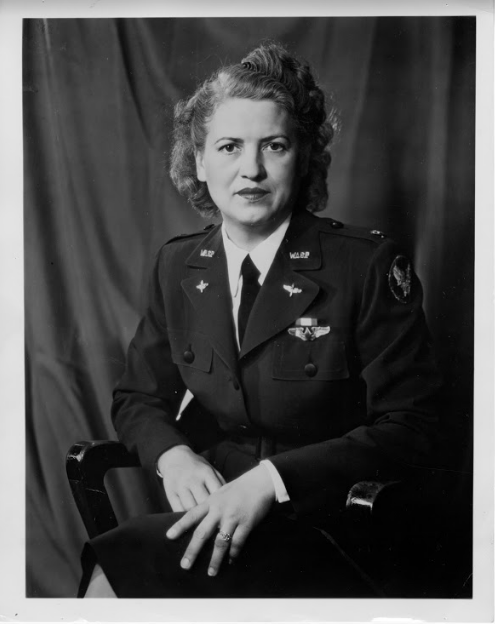
Jacqueline Cochran wearing her WASP uniform as Director of the WASPs during World War II. Eisenhower Presidential Library #91-4-5695
Lou Hoover and Women’s Suffrage
Future First Lady Lou Henry was 15 years old in 1889 when she wrote an essay arguing for Universal Suffrage. It would take three more decades until women were granted the right to vote in 1920. These records from the Hoover Presidential Library and Museum are from different perspectives and time periods leading up to the eventual passage of the 19th Amendment, granting women the right to vote.

A brief handwritten essay by Lou Henry Hoover, wife of the 31st President of the United States. Mrs. Hoover was 15 when she wrote this an essay on "Universal Suffrage".
Lou Henry opens her essay on universal suffrage written when she was fifteen by confessing ‘it is a subject to which I have given very little thought,’ then proceeds to write a thoughtful piece touching on philosophical and pragmatic points. She notes the inequity of women being denied the ballot while ‘the idiot, maniac and jail bird’ men can vote. Women property owners have no political recourse, and when allowed to vote on local issues, they often make education a Priority.
Herbert Hoover’s mother, Hulda, echoes a similar theme when she writes in her letter that a widow would welcome suffrage as a way to protect her business interests.
Anne Martin, a leader in the National Woman’s Party, describes suffragists being arrested at a White House protest in her letter to Lou Henry Hoover. Martin was a college classmate and friend of Lou Hoover. Her letters to Lou Hoover in 1911 and 1912 were often on suffrage letterhead, contained news clips on suffrage, and frequent reference to the amount of work to be done. Martin’s efforts were rewarded. By dint of the legislature voting in favor of suffrage in 1911 and 1913, Nevada women gained the right to vote in state elections in 1914.
Read more: https://hoover.blogs.archives.gov/2019/05/01/who-is-anne-martin-why-should-anyone-care/
The 19th Amendment had been passed by Congress, but was not yet ratified when Lou Hoover gave her luncheon address to students at Bryn Mahr in the spring of 1920. She discusses at length the importance of teaching, education, and civic engagement. She stresses using the right to vote properly, as a way to effect.
Lou Henry Hoover and the Girl Scouts Little House in Washington D.C.
Lou Henry Hoover was an active leader in the Girls Scouts of America for twenty-five years. One of the significant projects she was active in was the Girl Scouts Little House in Washington, D.C.
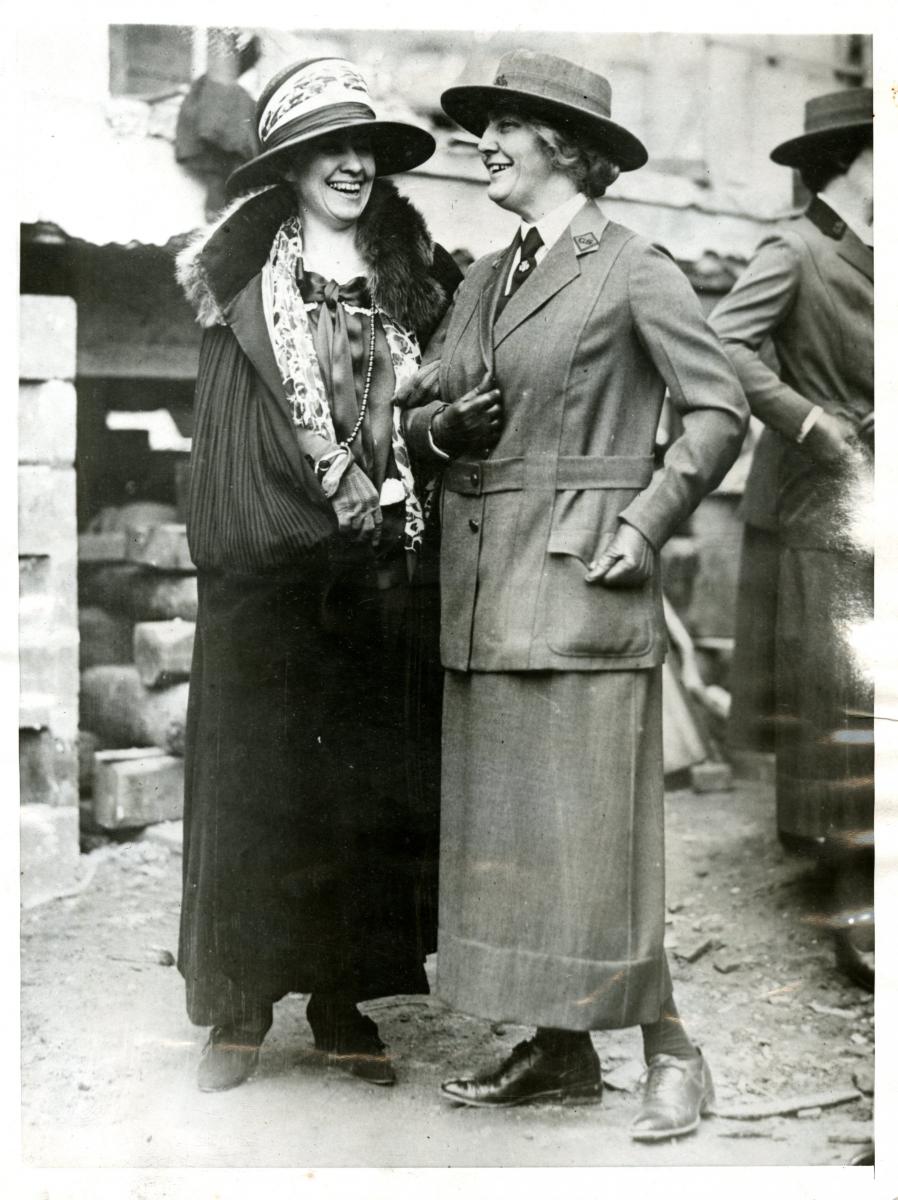
This photograph shows Lou Hoover and Grace Coolidge at the re-dedication of the Little House building on March 25, 1924. Originally a demonstration home for the Better Homes in America movement, Lou Hoover was involved in the transfer of the building to its new location at 1750 New York Avenue. Little Houses around the country were used by Girl Scouts to develop skills as homemakers, hosts, gardeners, and household management.

Lou Hoover worked closely with architect Donn Barber. This letter discusses ways to publicize the new Little House including using post cards.
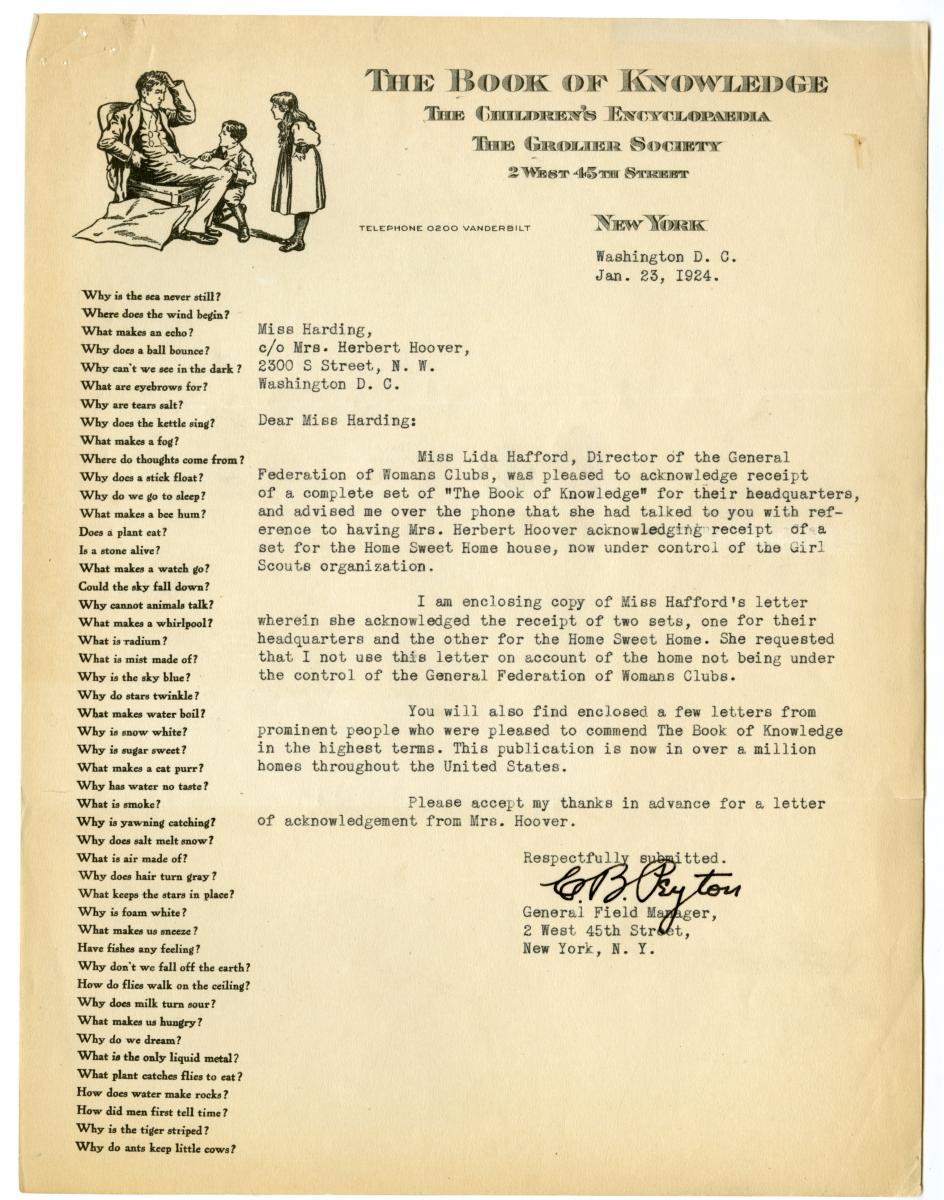
Lou Hoover attended to the furnishings of the Little House including selecting books for the library. This letter from The Grolier Society confirms delivery of the initial donation of a twenty-volume encyclopedia for children.

Lou and Herbert Hoover were among the dignitaries that returned to the Little House in November 1925 for the opening of National Girl Scout Week. Here is the first page of Lou Hoover’s draft describing the day’s events.
- The Reagan Presidential Library has digitized records related to Sandra Day O'Connor available on its topic guide entitled "Sandra Day O'Connor."
- See Photographs of Sandra Day O'Connor in the Reagan Presidential Library
See information on Frances Perkins on the FDR Library Website
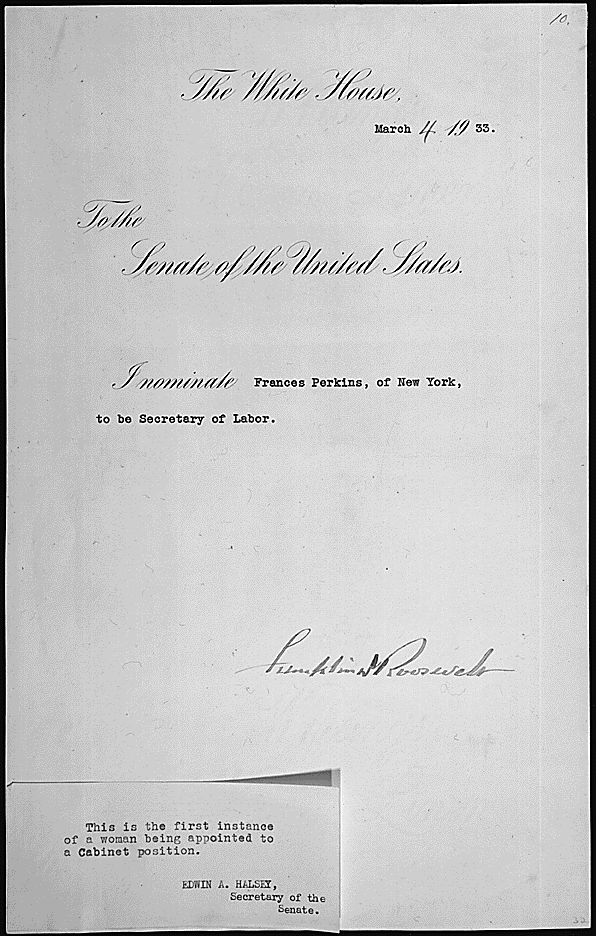
Message of President Franklin Roosevelt nominating Frances Perkins of New York to be Secretary of Labor
Janet Reno was nominated to be the first female U.S. Attorney General by President William Jefferson Clinton on February 11, 1993. She was confirmed by the U.S. Senate on March 11, 1993, and sworn in the next day. Reno is the second-longest serving Attorney General in United States history, serving in the position until 2001.
See the official U.S. Department of Justice biography for Janet Reno
The addresses she gave to the American people following her nomination and appointment to lead the Justice Department reflected the gravity of the events in the context of American history. In her nomination speech, she vows to work with the Clinton administration to end racial, ethnic and gender discrimination, protect America's children from abuse and violence, and enforce environmental and natural resources law. Her appointment speech speaks to the optimism permeating the American fabric just months after the inauguration of President Clinton, “I have sensed it for the last three days that there will be a new spirit in America where people will want to become involved in public service because it is the greatest undertaking you can commit for your nation.”
-from the William J. Clinton Presidential Library and Museum
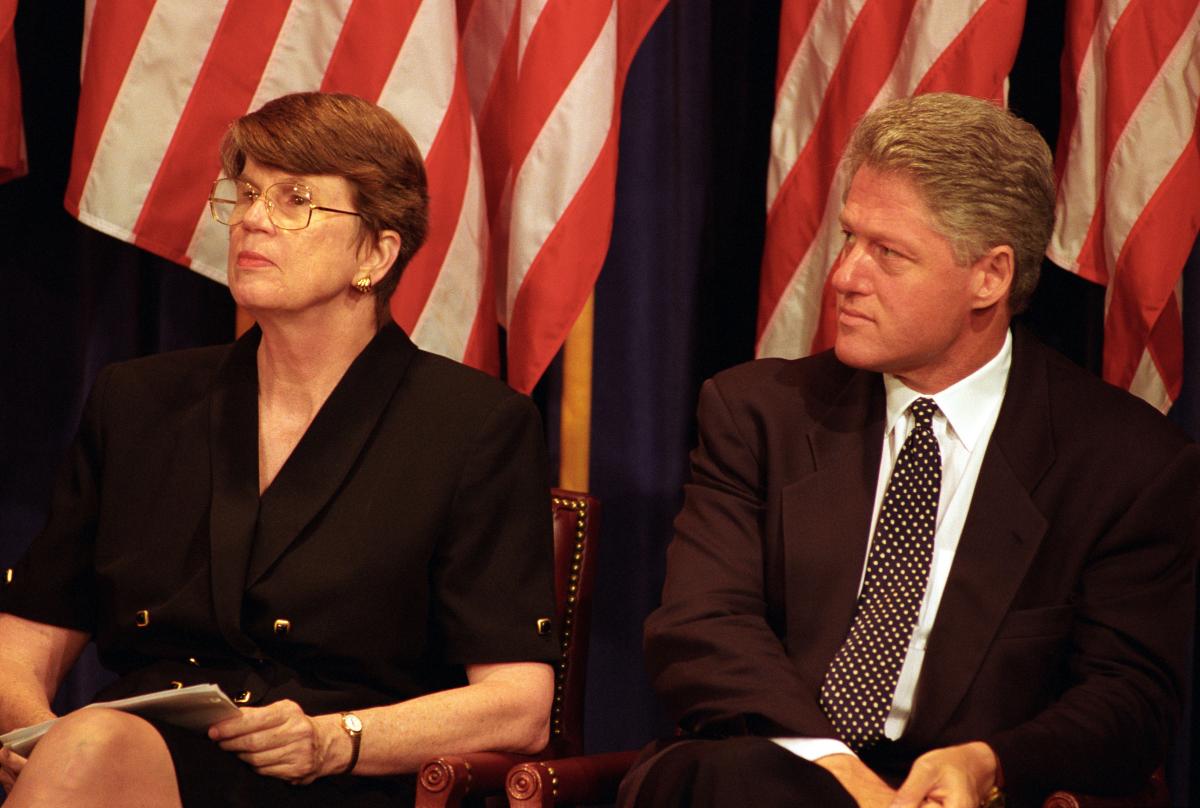
President Clinton and Attorney General Janet Reno participate in an event Announcing New Police Grants in the Old Executive Office Building on June 29, 1995. Photo by: A. Greenseid.
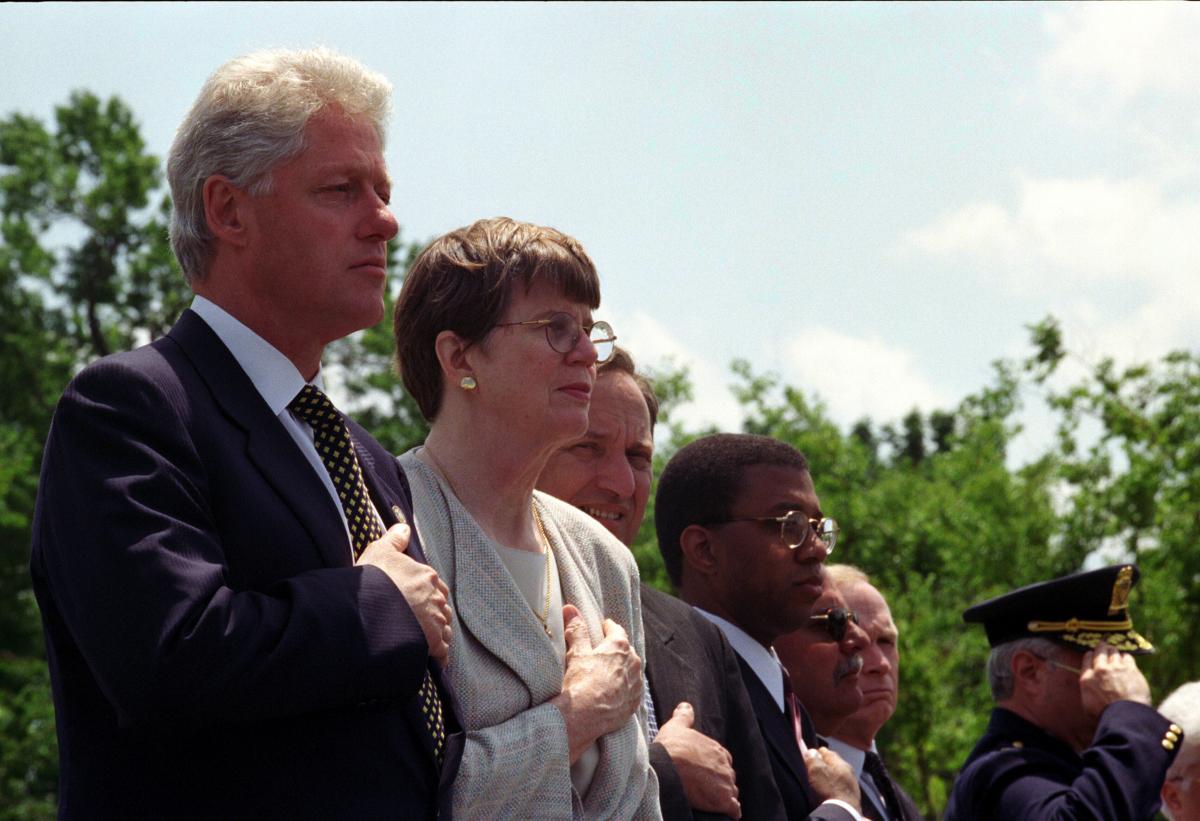
President Clinton and Attorney General Janet Reno Attend a Fraternal Order of Police Peace Officers Memorial Event at the United States Capitol in Washington, DC on May 15, 2000. Photo by: Ralph Alswang.
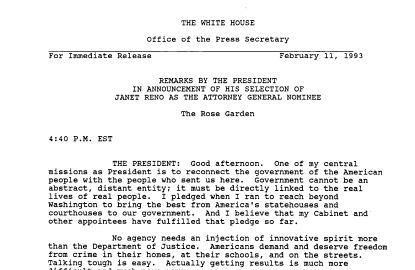
Reno delivers statements about her nomination and appointment as Attorney General. Clinton - Appointments [1] (Nomination of Reno: WJC remarks p. 30-31 , Reno remarks p. 31-32, Q&A p. 32-37, Reno bio p. 38; Swearing-in of Reno: WJC remarks page 67, Reno remarks p. 68). National Security Council, Office of Press and Communications, and Philip "PJ" Crowley, “Clinton - Appointments [1]
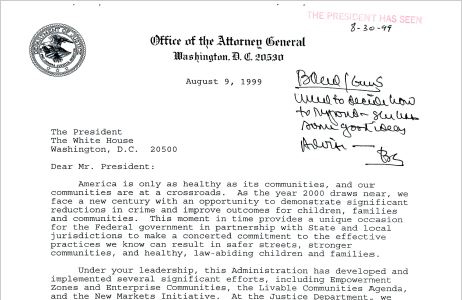
Before President Clinton’s last year in office, Reno outlined several bold policy proposals that would result in “safer streets, stronger communities, and healthy, law-abiding children and families.” In her letter to the president, she detailed progressive strategies to create safer schools and healthier students, expand grant programs aimed at enhancing quality of life, and improve reentry programs for released inmates.
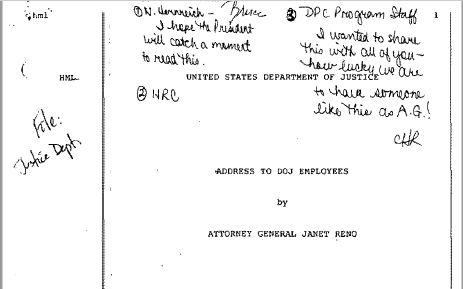
Reno delivers a statement about the philosophy and goals of the Justice Dept. to DOJ employees. She stresses “Doing the right thing” and the role law should play in the betterment of the lives of all Americans. A little less than a month after being sworn in as Attorney General, Reno addressed the thousands of men and women who work for the Department of Justice. She speaks to the guiding principles of the law and outlines her goals for the Department. Throughout the address she reminds the staff of the injustices suffered by everyday Americans by challenging them to continually ask “What is the right thing to do?”.
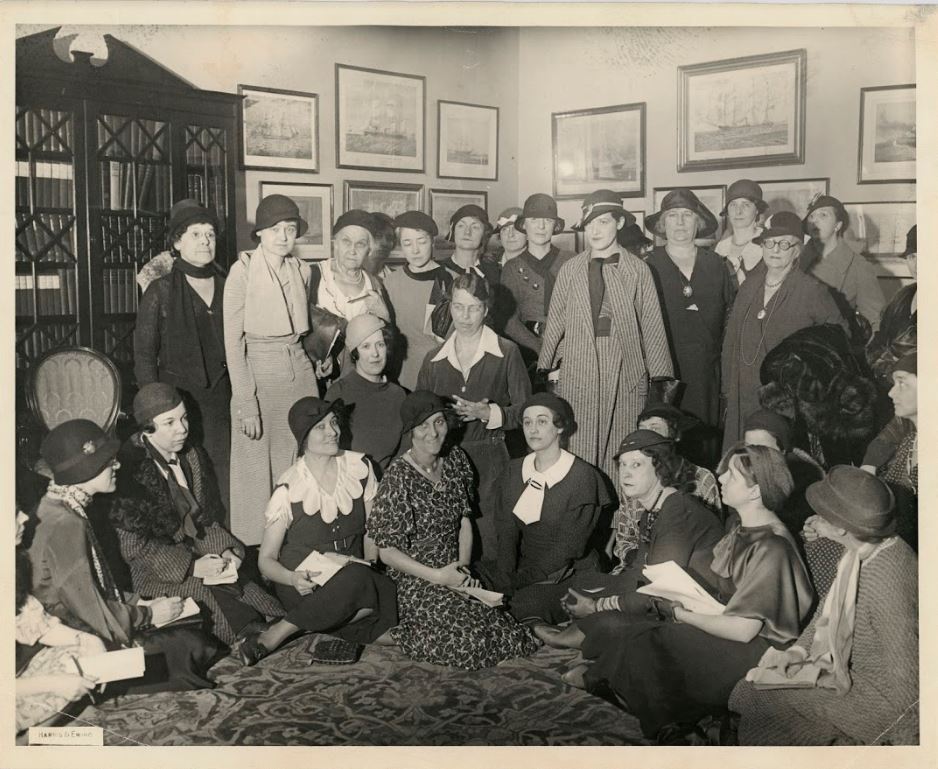
Eleanor Roosevelt press conference in the Monroe Room of the White House, 1933. Credit: Franklin D. Roosevelt Presidential Library Photograph Collection, NPx 48-22:3724(6)
Eleanor Roosevelt and the First White House Press Conference for Women
On March 6, 1933 Eleanor Roosevelt held the first of her 348 women’s only press conferences. Before this time, First Ladies had little contact with reporters. Eleanor recognized that holding regular conferences could enhance the public role of the First Lady - a role she transformed during her 12 years in the White House.
About 35 women attended Eleanor’s first press conference which was held in the Monroe Room on the second floor of the living quarters in the White House. The press conferences were attended by the major female reporters of the day - including Lorena Hickok, Ruby Black, Bess Furman, May Craig, Emma Bugbee and Martha Stayer.
Eleanor used these press conferences as a way to not only announce her schedule of activities but also as a platform to publicize the work of women leaders, answer her critics, and entertain questions on a variety of subjects. Topics covered everything from domestic issues like social programs, race, youth activism, etc. to international politics and the role of women in war and peace.
-from the Franklin D. Roosevelt Presidential Library
Research the Roosevelts, Eleanor Roosevelt portal
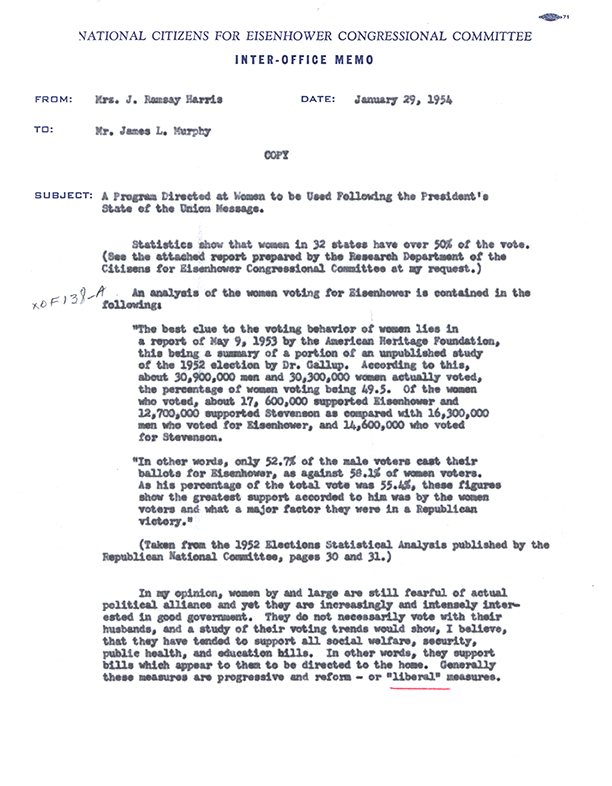
Letter from Mrs. J. Ramsay Harris to James Murphy
Mrs. J. Ramsay Harris to James Murphy re a program directed at women to be used following the President's State of the Union message, January 29, 1954 [DDE's Records as President, Official File, Box 852, OF158 Women]
The image of American women in the 1950s was heavily shaped by popular culture: the ideal suburban housewife who cared for the home and children appeared frequently in women’s magazines, in the movies and on television. It is true that the women who entered the workforce during World War II did, for the most part, return to home and family in the following years, but during the 1950s the trend began to turn. Women began returning to the workplace and more and more women were becoming involved in state, local and Federal government service.
Eisenhower’s 1952 presidential campaign was supported by a larger percentage of women voters than men, helping ensure his election. It was suggested that Eisenhower develop a program in recognition of their support. In addition to appointing more women to government positions, Eisenhower should appeal to all women through addressing the issues of most concern to them.
- from the Eisenhower Presidential Library
Educational Resources
- DocsTeach: Women Who Pushed the Boundaries
- DocsTeach: Susan B. Anthony & Other Women Arrested for Illegally Voting in the 1872 Election
Research at the National Archives
Catalog Collection Highlights

"Portraits of Outstanding Americans of Negro Origin Painted by Two Women Artists", ca. 1943 - ca. 1963
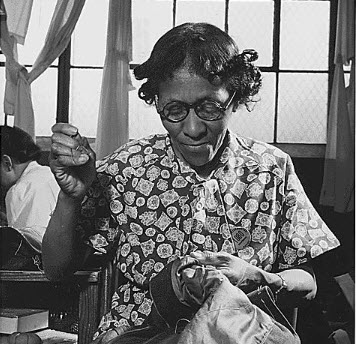
Negro Activities in Industry, Government, and the Armed Forces, 1941 - 1945
- I too, am Rosie, from NARA's Rediscovering Black History blog
- Women in Black Power
- Women in War Time Civilian Government Employment, presentation slides
Articles
Women of the Polar Archives The Films and Stories of Marie Peary Stafford and Louise Boyd. Prologue magazine. Summer 2010, Vol. 42, No. 2
Film
Susan B. Anthony
- Susan B. Anthony and the Struggle for Suffrage, Teachable Texts
Margaret Sanger
- Documentary Editors on the World Wide Web: The Margaret Sanger Papers, article in The Record, September 1998
- Margaret Sanger: The Woman Rebel, Teachable Texts
- Margaret Sanger Indictment 1914, in the Records of Rights exhibit
Laura Ingalls Wilder
- Teaching With Documents: Little House in the Census - Almanzo and Laura Ingalls Wilder
- Laura Ingalls Wilder website, Herbert Hoover Presidential Library
- De Smet, Dakota Territory, Little Town in the National Archives , article in Prologue, Winter 2003
Highlights from the Catalog
- Powers of Persuasion, Poster Art from World War II, exhibit
- I too, am Rosie, from NARA's Rediscovering Black History blog
While many resources are available online for research, there are many more records to discover in National Archives’ research rooms across the country. The following records have been described at the Series and File Unit level, but have not yet been digitized. This list is not exhaustive; please consult our Catalog to browse more records, and contact the Reference Unit listed in each description for more information.
- Women in the Public Service, 1959: Dwight D. Eisenhower Presidential Library
- Women in Black Power
Articles, Blog posts, and Other Resources
- Claim of Harriet Tubman
- President Ronald Reagan's Nomination of Sandra Day O'Connor to be Associate Justice of the Supreme Court of the United States, August 19, 1981
- A Tribute to Ambassador Corinne "Lindy" Boggs
- Election Certification of Hattie Caraway
- Taking a Stand for Voting Rights: Prologue Magazine
- Betty Ford Danced to Her Own Beat: Pieces of History blog
- Change at their fingertips: Women's petitions to Congress: Pieces of History blog
- Eugenie Anderson's Historic Firsts: Pieces of History blog
- Annie Oakley: A Woman to be Reckoned With: Pieces of History blog
- Harriet Beecher Stowe: A Fighter for Social Justice: Pieces of History blog
